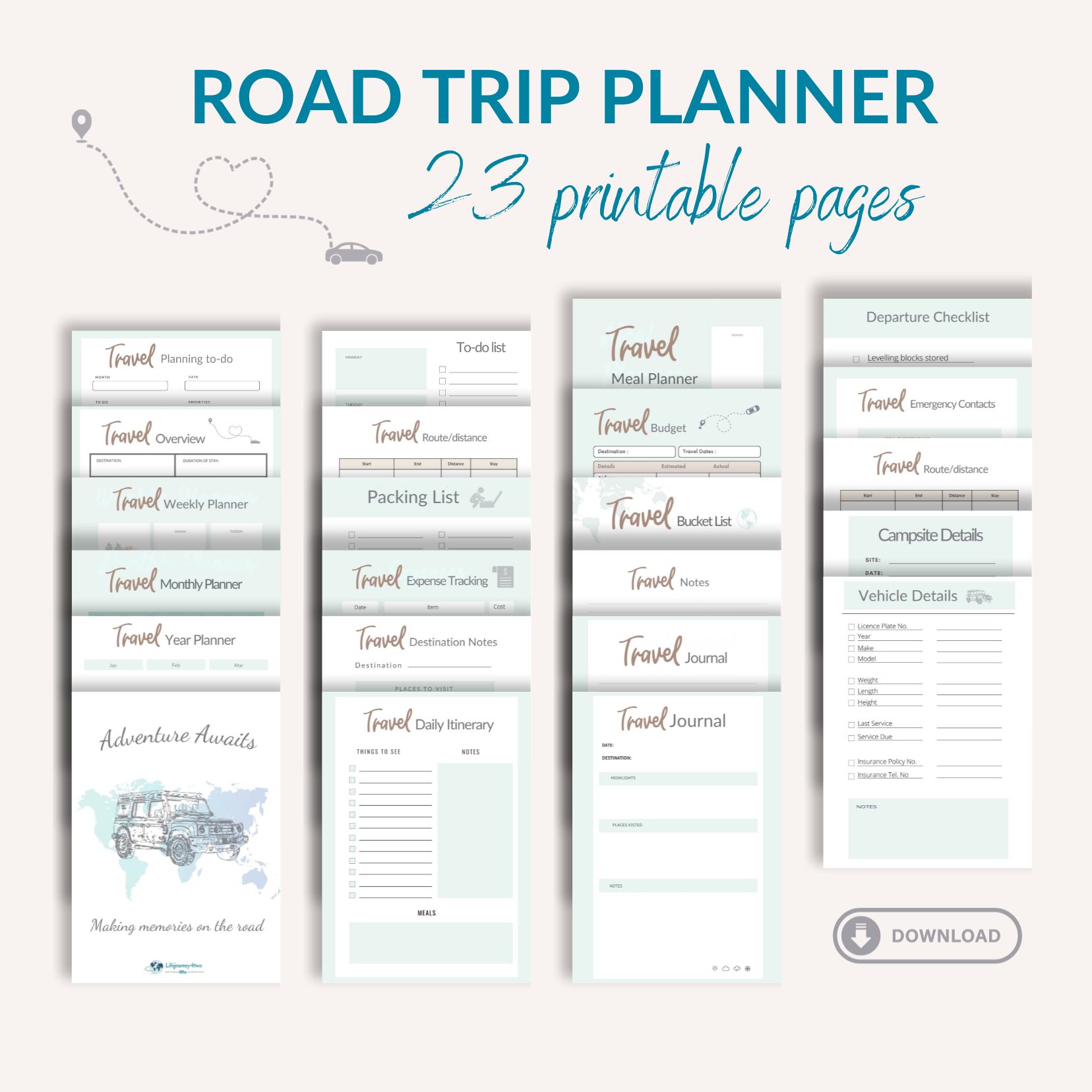Want to know what to do in Luderitz Namibia? Then you’ve come to the right place.
We visited Luderitz on our two-month Namibian road trip, thinking we’d have some downtime. But as it happened, there were many things to do in Ludertiz.
Diamonds, ghost towns, wildlife, and remote wilderness are all intertwined with this windy town, which is lined with German colonial architecture and restaurants promising the freshest seafood.
You will be blown away by all the things to do in Luderitz … and if you hit the town in strong winds … you may actually be blown away!
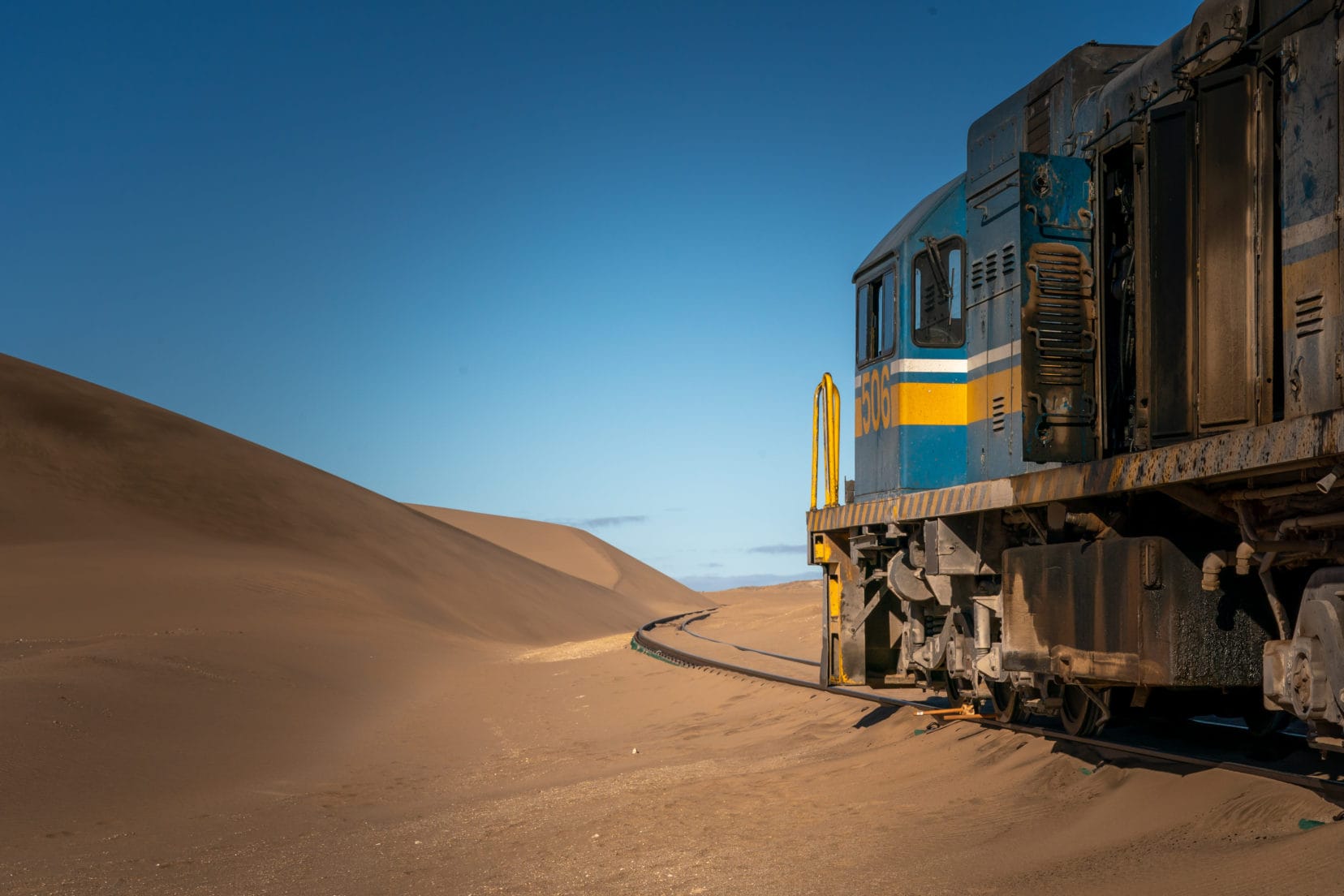
If you’re wondering what to do in Luderitz Namibia, click on the links below to jump to parts that interest you, or take a leisurely browse and travel through Luderitz with us and enjoy the photos.
👀 Quick Overview of 15 Things to Do in Luderitz, Namibia
This list isn’t exhaustive, but it will give you a good idea of what to do in Luderitz, Namibia:
- Visit Kolmanskop Ghost Town
- See the Wild Horses of the Namib Desert
- Take the Scenic Route on Luderitz Peninsula
- Birdwatch at the Lagoon and on the coast
- Stand on Dias Point
- Admire the Views at Shark Island
- Stroll along Agate Beach
- Step backing time at Luderitz Museum
- Sample Luderitz Seafood
- Climb the hill to Felsenkirche
- Watch the Luderitz Speed Challenge
- See the penguins at Halifax Island
- Visit Sperrgebiet National Park on a tour
- Wander Luderitz and marvel at its Art Nouveau architecture
- Tour Goerke Haus – once the most extravagant house in Luderitz
Sneak Peek Video of Luderitz
Planning a Trip to Namibia?
- 🚗 Hiring a car? We recommend getting a quote from DiscoverCars
- 🚐 Hiring a campervan? We recommend Motorhome Republic
- ⛑ Arranged your travel insurance? Compare quotes from World Nomads & Safetywing
- 🪪 Order your International Driver’s Licence online here
- 🏩 Booked your accommodation? We use Booking.com to find the best deals
- 🐾 Is someone pet-sitting for you? 🐾 We use and love TrustedHousesitters
- (Get 25% off at checkout for new memberships with our discount code: LIFEJOURNEY25)
Map: Things to Do in Luderitz Namibia
15 of the Best Things to Do in Luderitz
We’ve gathered together all the best things to do in Luderitz: a mix of landscapes, wildlife, history and, in our opinion, the best bit of all — Kolmanskop Ghost Town.
1. Kolmanskop Ghost Town
Kolmanskop Ghost Town has to be one of the biggest drawcards for Luderitz. And it was certainly our favourite thing to do in Luderitz.
Being avid photographers, we’d say that Kolmanskop has to be on your list of places to visit in Namibia. It is hauntingly beautiful, and witnessing the desert reclaim this once-thriving diamond mine town stirs reflections of our own impermanence.
The town came into existence in 1908 when the first diamonds were discovered. The town was built with the wealth being generated from the diamonds, and as the inhabitants were German, the buildings were built in classic colonial style and to a high standard.
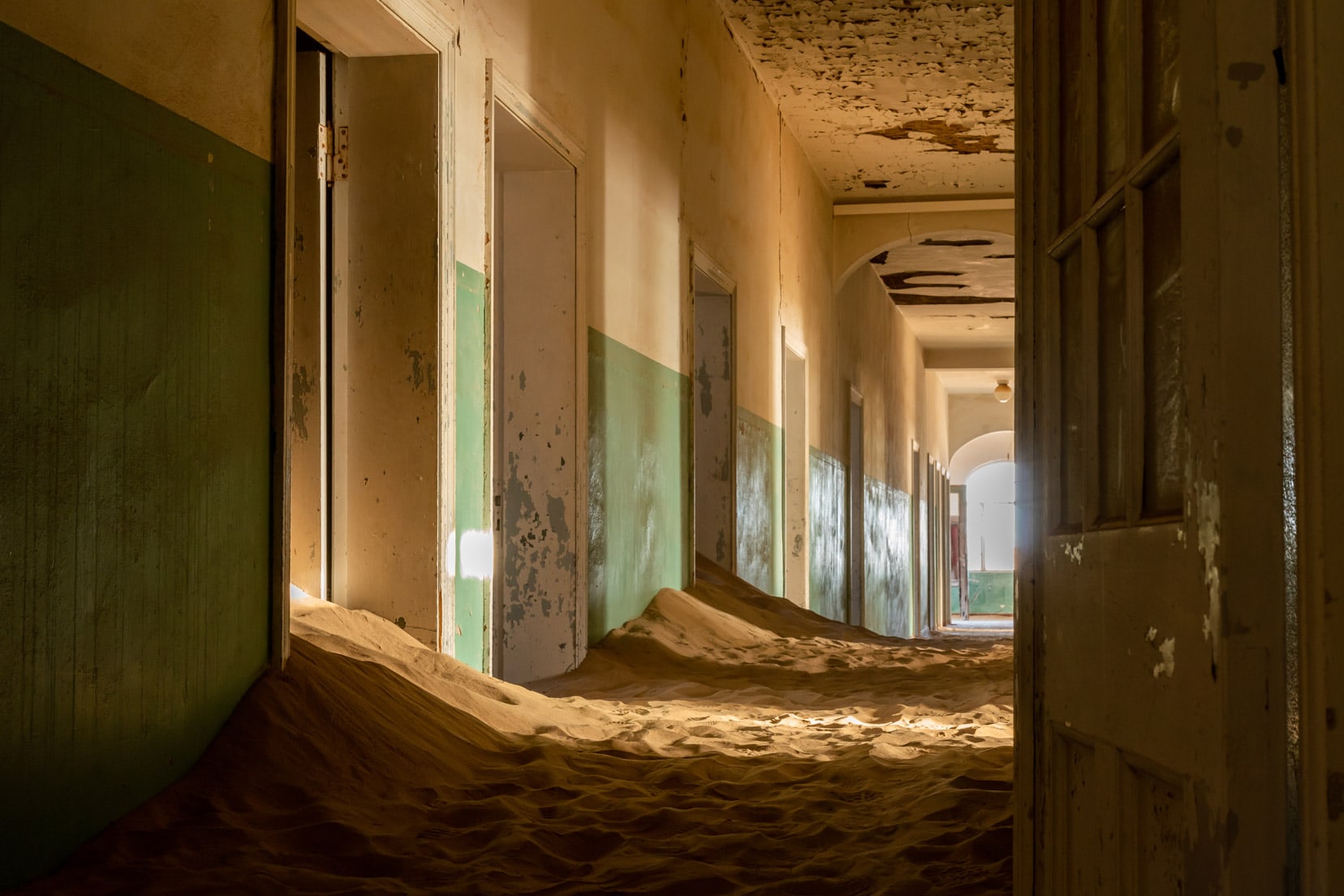
After the First World War, as the mining area became depleted and more lucrative diamond mining areas were found further south, the town began a decline. The last person left Kolmanskop in 1956.
Now, the only people to walk around this once-bustling mining town are tourists. Sand has encroached into every corner, barricading rooms and swallowing the past.
Exploring Kolmanskop’s sandy embrace calls for some serious photography skills. Brush up on your techniques with our essential Travel Photography Gear Guide to capture these moments perfectly.
Details:
- Entrance for a standard visit ( tour is included) is N$130 per person (from 8 am to 1 pm Daily)
- If you want to enter at sunrise, you need to buy a permit on the previous day, and then you can enter at any time during the day, including the sunset. The cost of that ticket is N$330.
- Tours as part of the entry price are at 9.30 am and 11.00 am Mon-Sat, and at 10.00 am on Sundays and holidays.
This was one of our favourite Luderitz things to do.
🗺️ Kolmanskop is about 13 km from Luderitz, about a 15-minute drive.
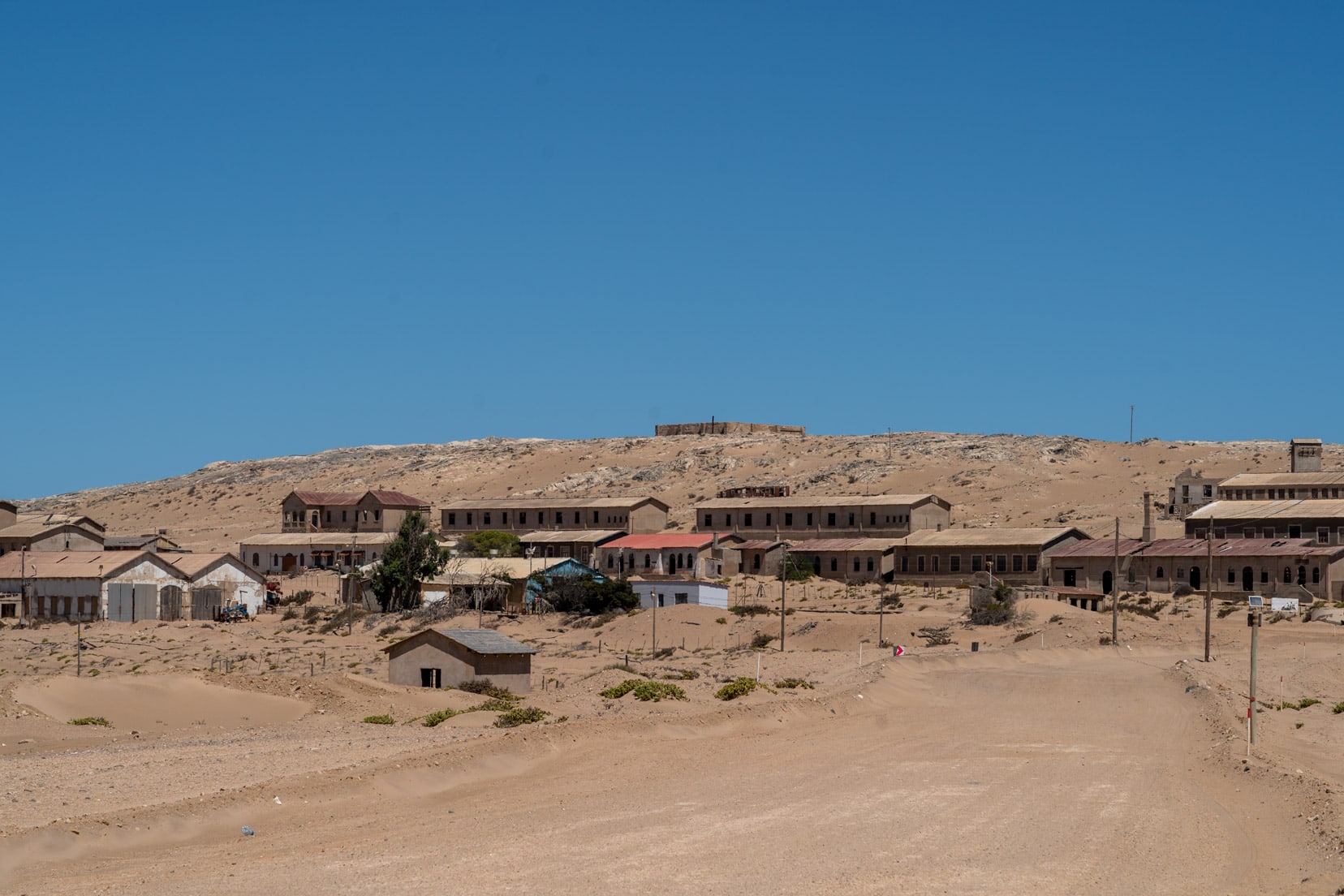
2. Visit Garub Pan to see the Namib Wild Horses
One of the best places to see the Namib wild horses is the special lookout at Garub Pan, just off the B4. It’s about 20 kilometres from Aus, on the way to Luderitz.
Unfortunately, the numbers of these feral horses are dwindling. What was once a group of over 200 horses, now only around 70 remain.
The waterhole that helps sustain them has been beneficial to a spotted hyena clan. With available water and young foals on tap as prey, these hyenas are reluctant to move on. This, in turn, is affecting the sustainability of these wild horses of the Namib.
There are ongoing debates as to how to solve the situation. But for the moment, if you are lucky, you can still see these iconic horses surviving as best they can, digging for roots in the parched land.
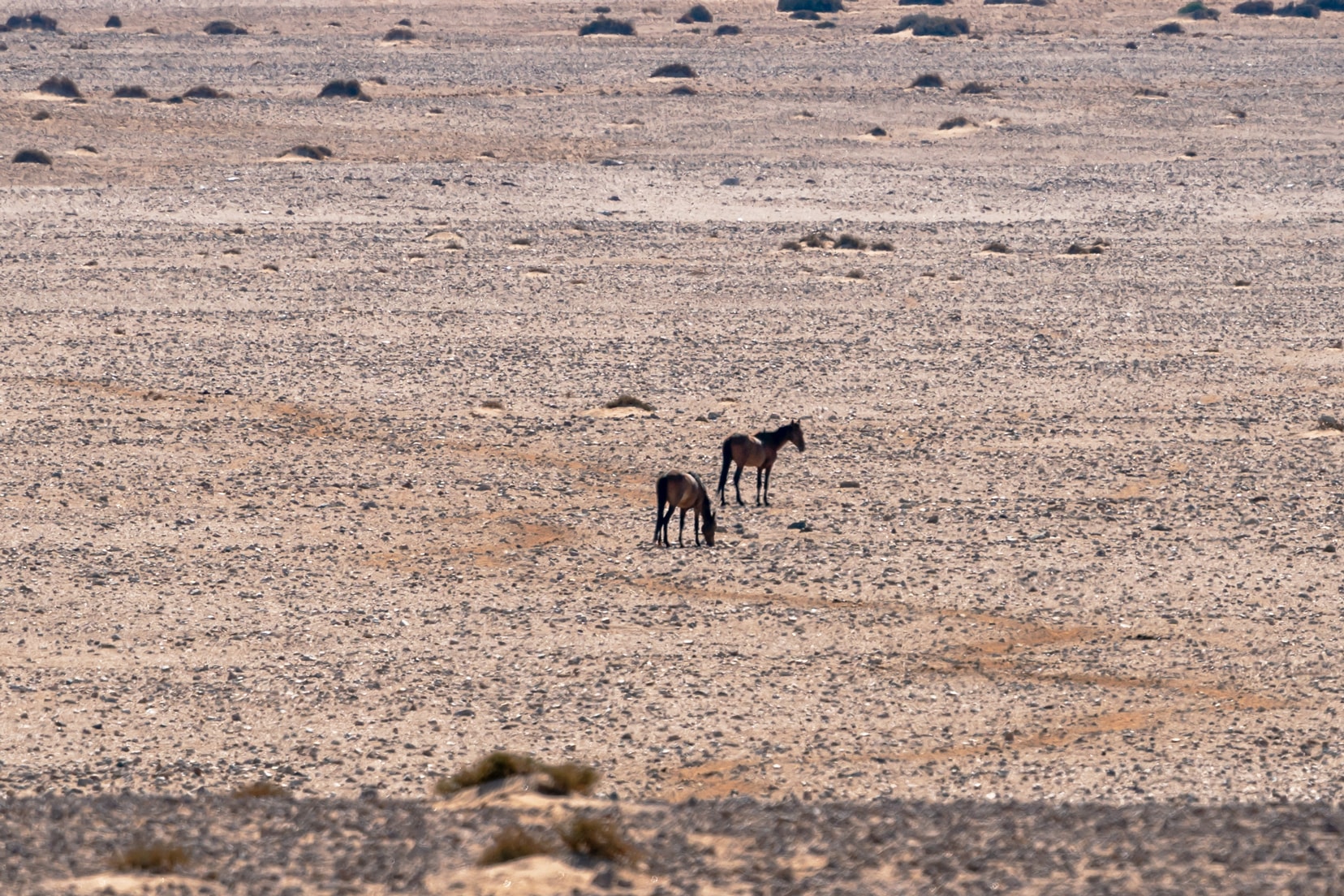
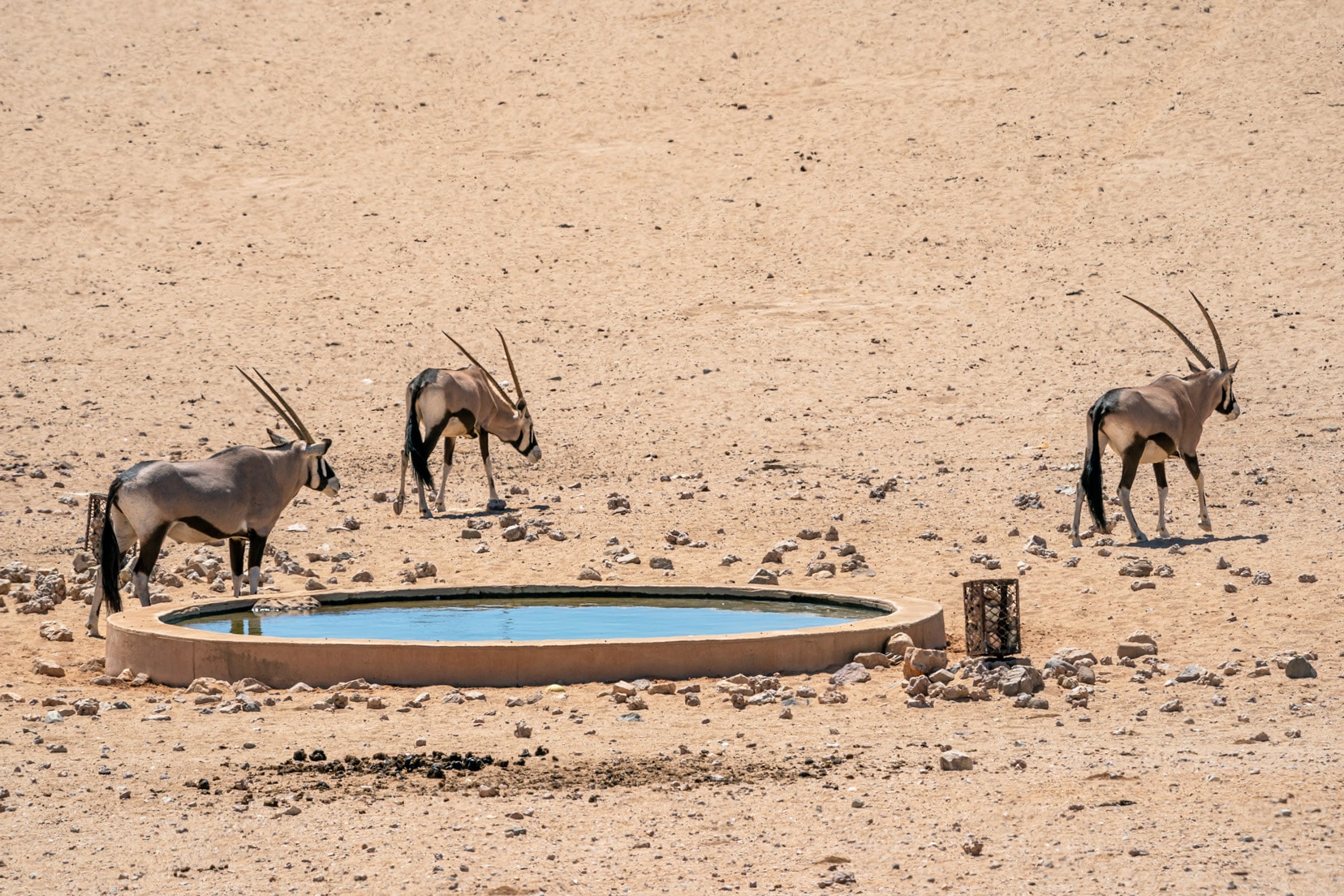
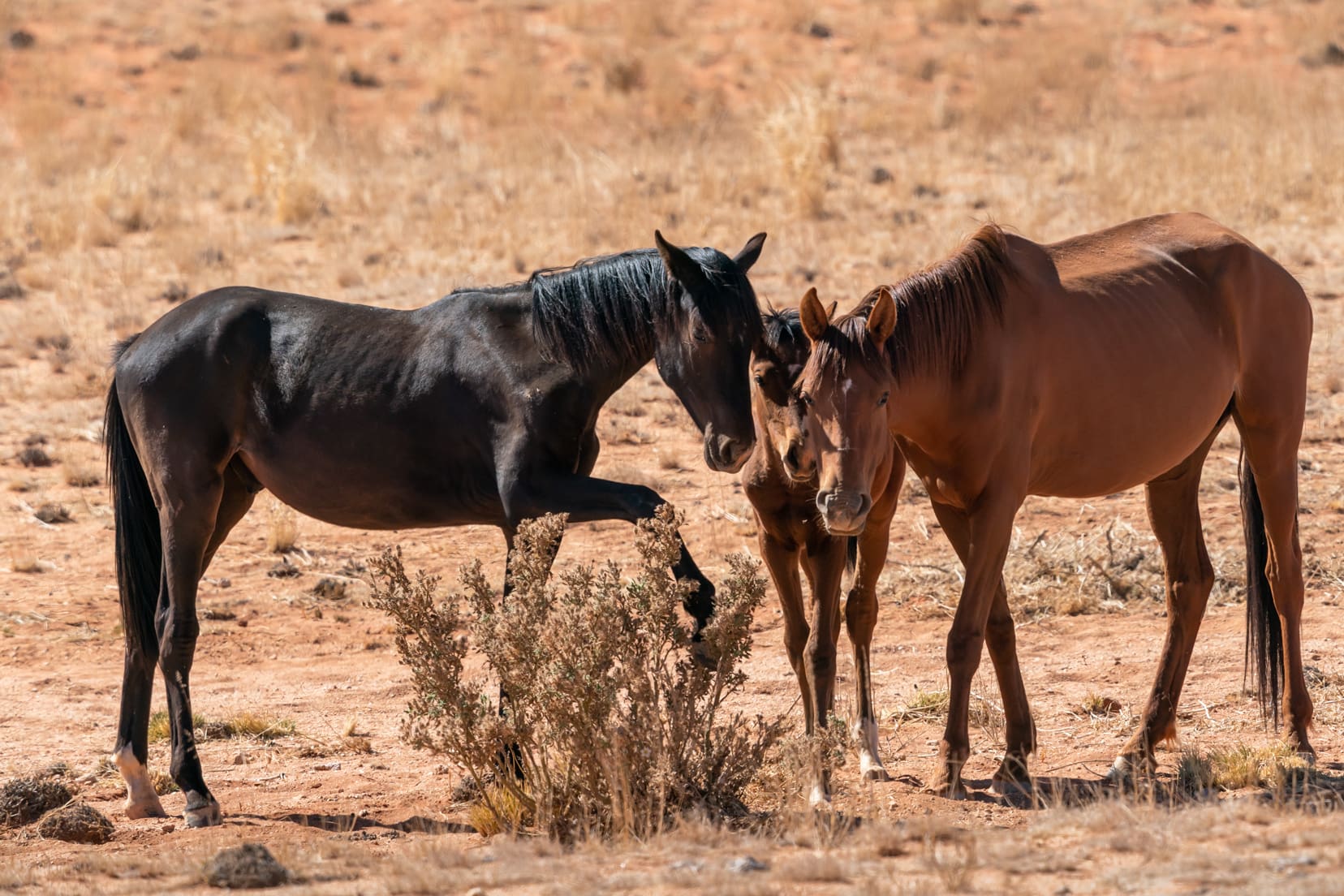
3. Drive the Scenic Seaside Route to Grosse Bucht
For a good introduction to the landscape around Luderitz, take a circular route around the rocky shoreline of Luderitz Penisula.
From the town, drive past Second Lagoon and Grosse Bucht (Large Bay) towards Diaz Point, and then return via the coast on the eastern side of the peninsula. (See map above for route).
Humpback whales have been spotted in the bay on occasion, so stop and get out of the car for great views across the bay; you never know what you might see swimming by. Maybe some local Heaviside dolphins or Cape fur seals.
Spotting dolphins and seals off the coast is a highlight, much like a safari. Hone your wildlife photography on the coast with tips from our Safari Photography Tips article.
The eastern side of Grosse Brucht is out of bounds to the public, as it’s part of the Sperrgebiet (a forbidden zone), created when the diamonds were discovered in the area.
Today, it’s still a serious offence to trespass in the no-go zones marked all along the B4 (as you drive into Luderitz) and in many areas around Luderitz.
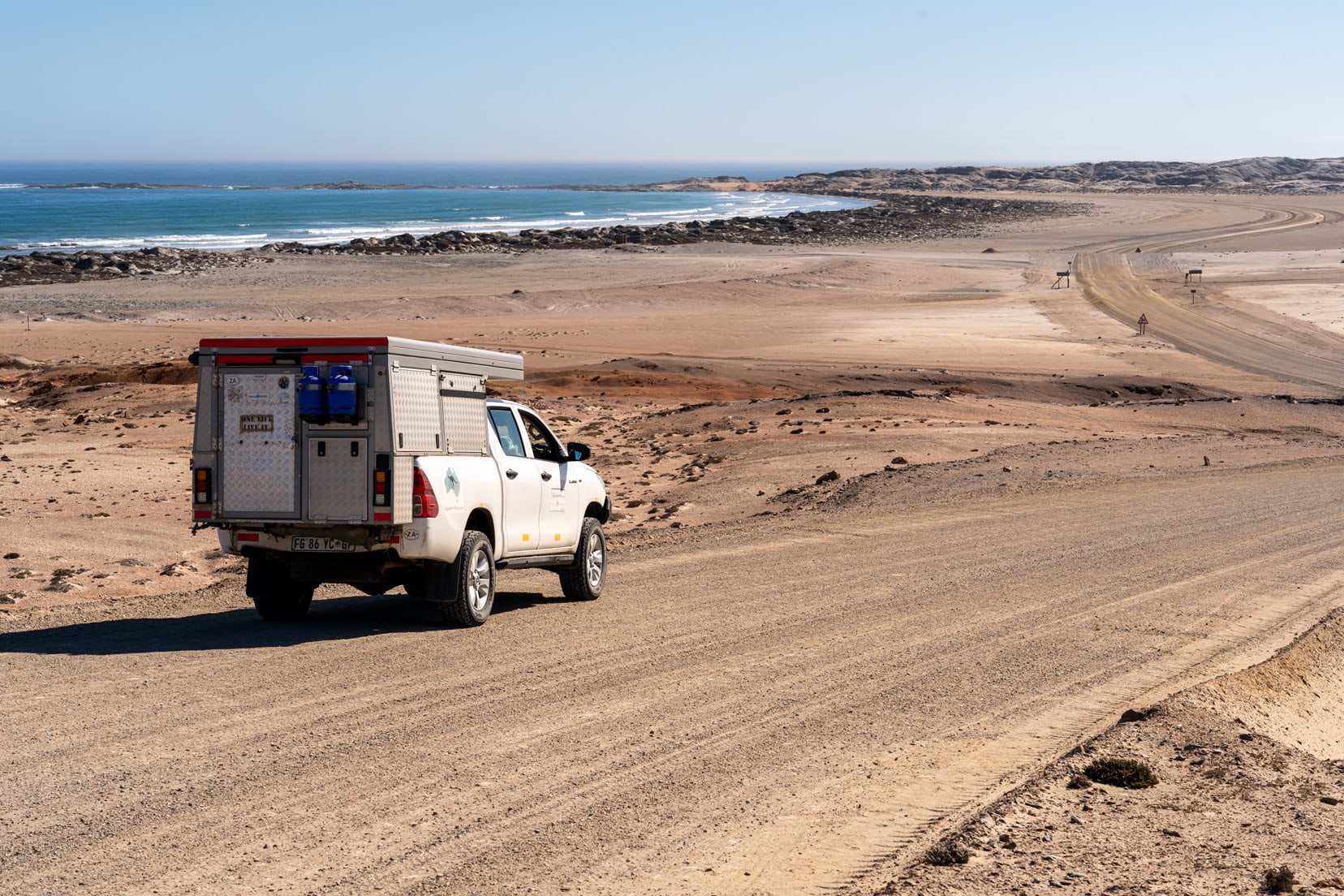
4. Birdwatching
On the drive from Luderitz to Gross Buchte and Dias Point, we saw lots of flamingos, particularly at Second Lagoon and on the coastal area with Dias Lighthouse in the distance.
Near to Grosse Buchte is a Damara tern breeding area, and depending on the season, you may also spot common terns, sandwich terns, swift terns, white-fronted plovers, white-chinned petrels, sooty shearwaters, Cape Gannets, bank Cormorants, crowned cormorants, albatross, and more at the Luderitz Peninsula.
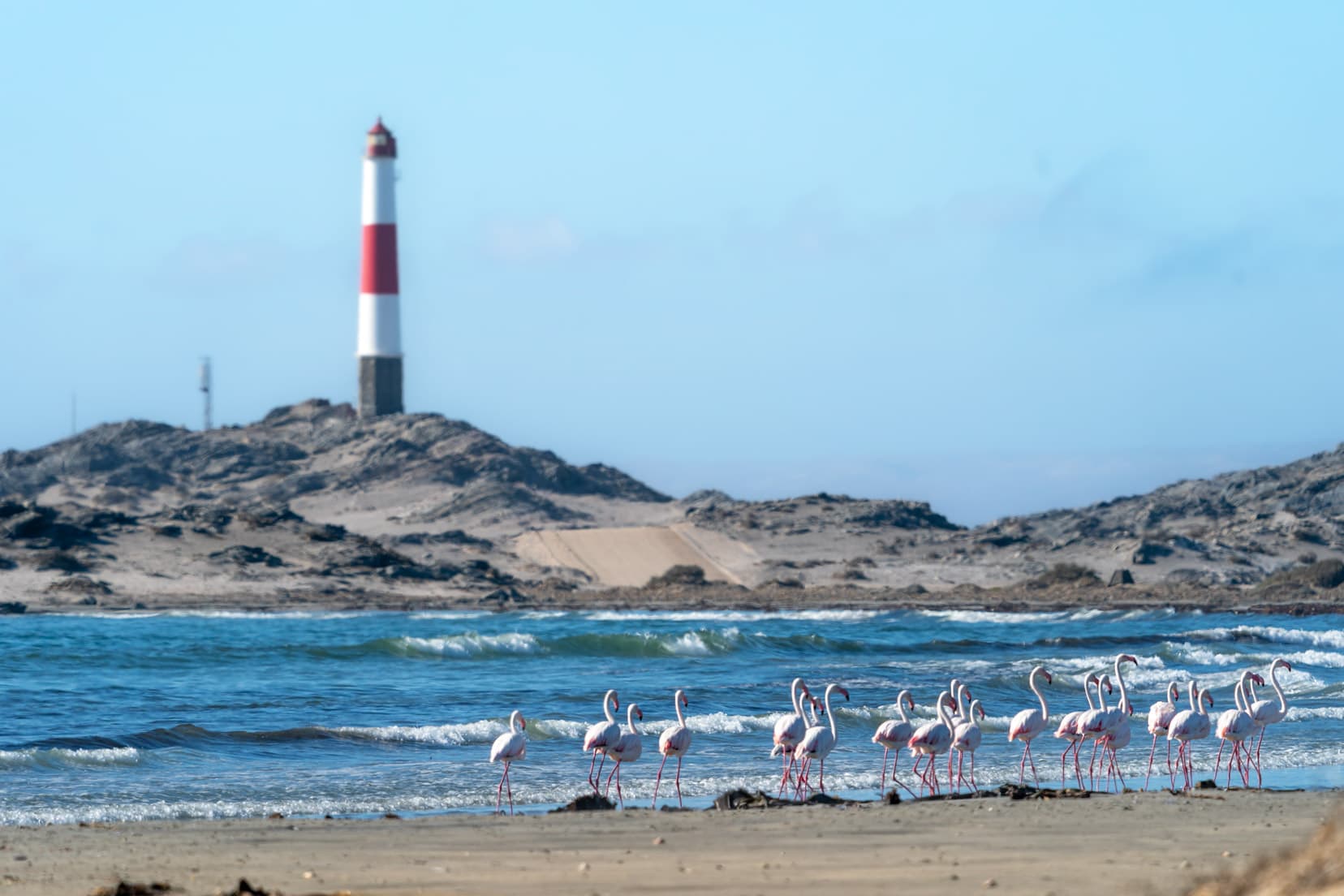
5. Stand at Dias Point
Portuguese explorer Bartolomeu Dias landed in what is today known as Luderitz in 1488. He installed a cross (a padrao) to mark his landing at this bay on his route around the tip of Africa. Dias named the bay Angra Pequena, meaning Small Bay in Portuguese.
The Dias Cross was declared a National Monument, and today, a replica cross carved from the same Namib dolerite that forms the surreal sculptures in the Giant’s Playground stands in its place. Discover more about these formations in our Quiver Tree and Giants Playground post.
You can only visit the Dias cross at low tide because the bridge that was once a causeway to the cross no longer exists, with only a few fragments remaining.
Across the bay from Dias Point is the Dias Point lighthouse. It opened in 1915 and is 28 m high. Interestingly, the lighthouse foghorn is 450 meters north of the lighthouse itself.
There is also a small cafe at Dias Point, Skip Skop — an ideal place to stop for coffee and cake.
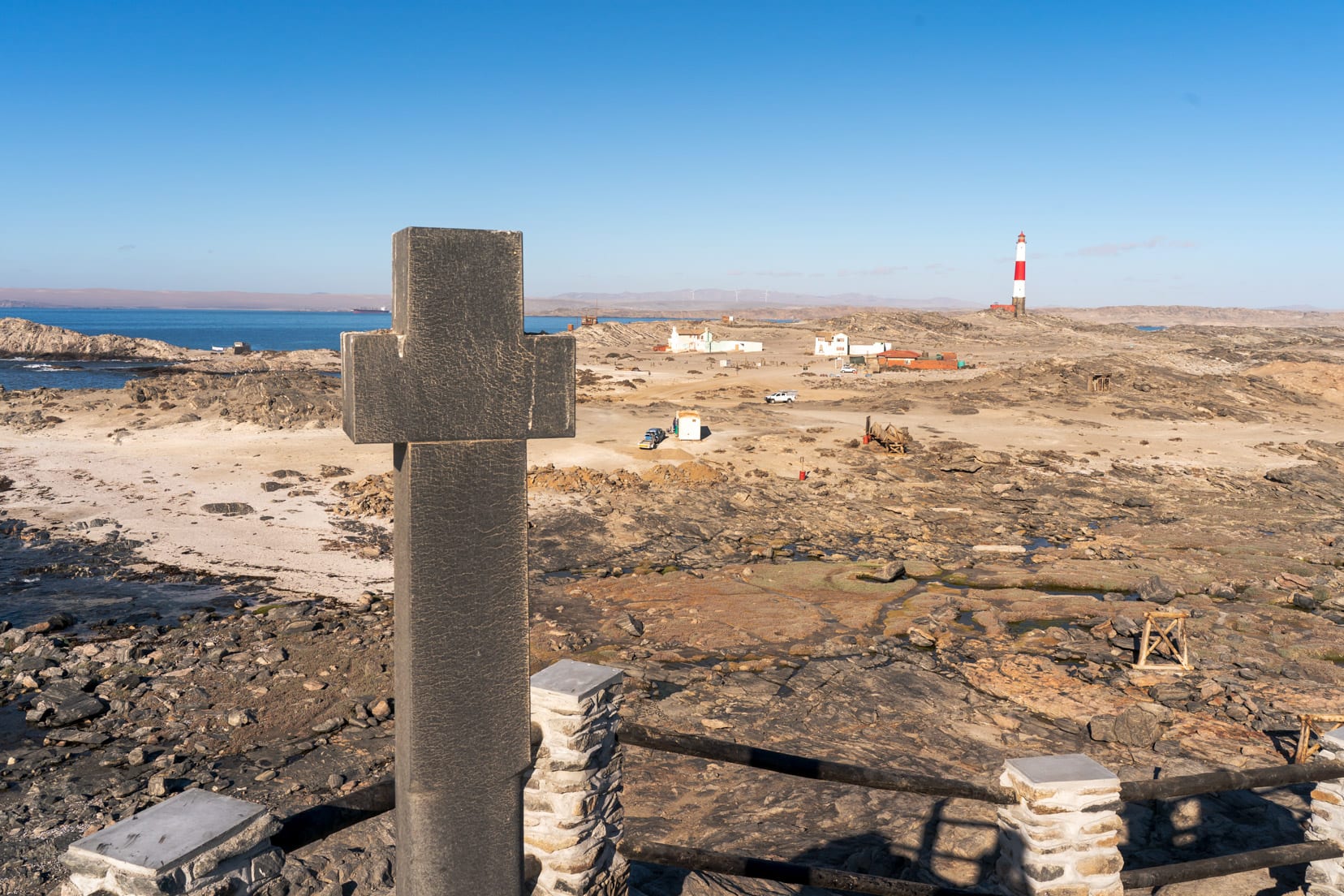
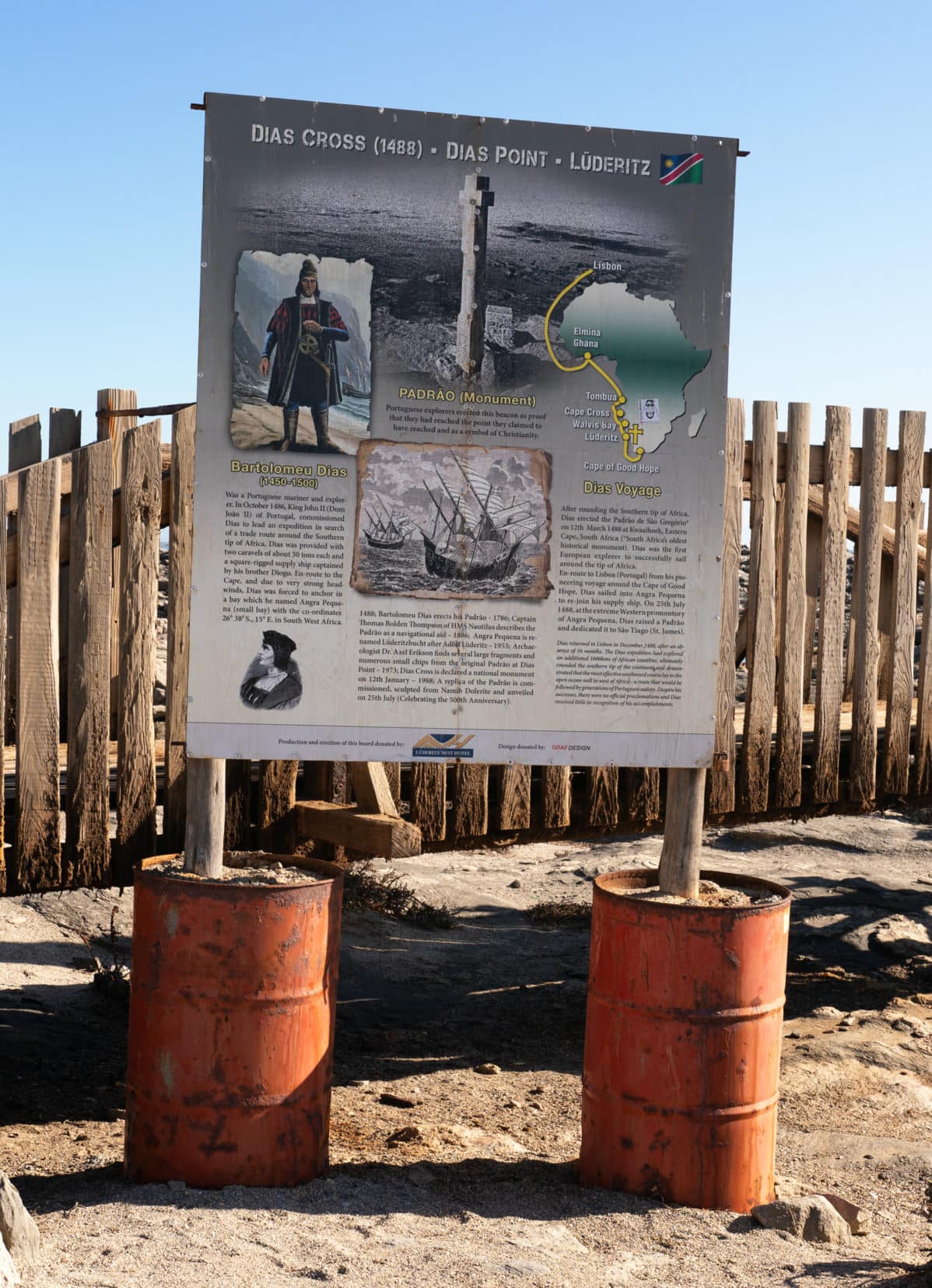
6. Shark Island
Shark Island, isn’t, as its name suggests, an island. It is a peninsula within the heart of Luderitz. Before the arrival of the German colonialists, it was but was later connected to the mainland.
Today, it is a great place to view Luderitz Bay and Penguin Island to the north. There is also a campsite, with ocean views and electricity… for the hardy campers.
With Lüderitz’s reputation for strong winds, I would imagine that you need a certain love of being buffeted and pummelled for a camping stop here to be enjoyable.
If the forecast was for little wind, it may be worth the risk. Otherwise, you may find yourself blown half away across the South Atlantic and end up somewhere in the midst of South America.
In the middle of Shark Island, you’ll find a memorial to Adolf Luderitz, founder of Luderitz, and one to the German soldiers who lost their lives during the colonial rebellions against the local Herero and Nama people in the early 1900s.
Although the bougainvillea-framed views back to Luderitz town are pretty, Shark Island’s past isn’t so attractive.

After the Herero Wars, the Germans established a concentration camp on Shark Island, and around 3000 Herero and Nama people died there. It was known as “Death Island’ as so many died due to hunger, beatings, forced labour, sexual abuse and exposure to harsh conditions without shelter.
There is no obvious memorial on Shark Island in memory of this — which seems strange to an outsider. This dark past won’t just blow away in the prevailing winds.
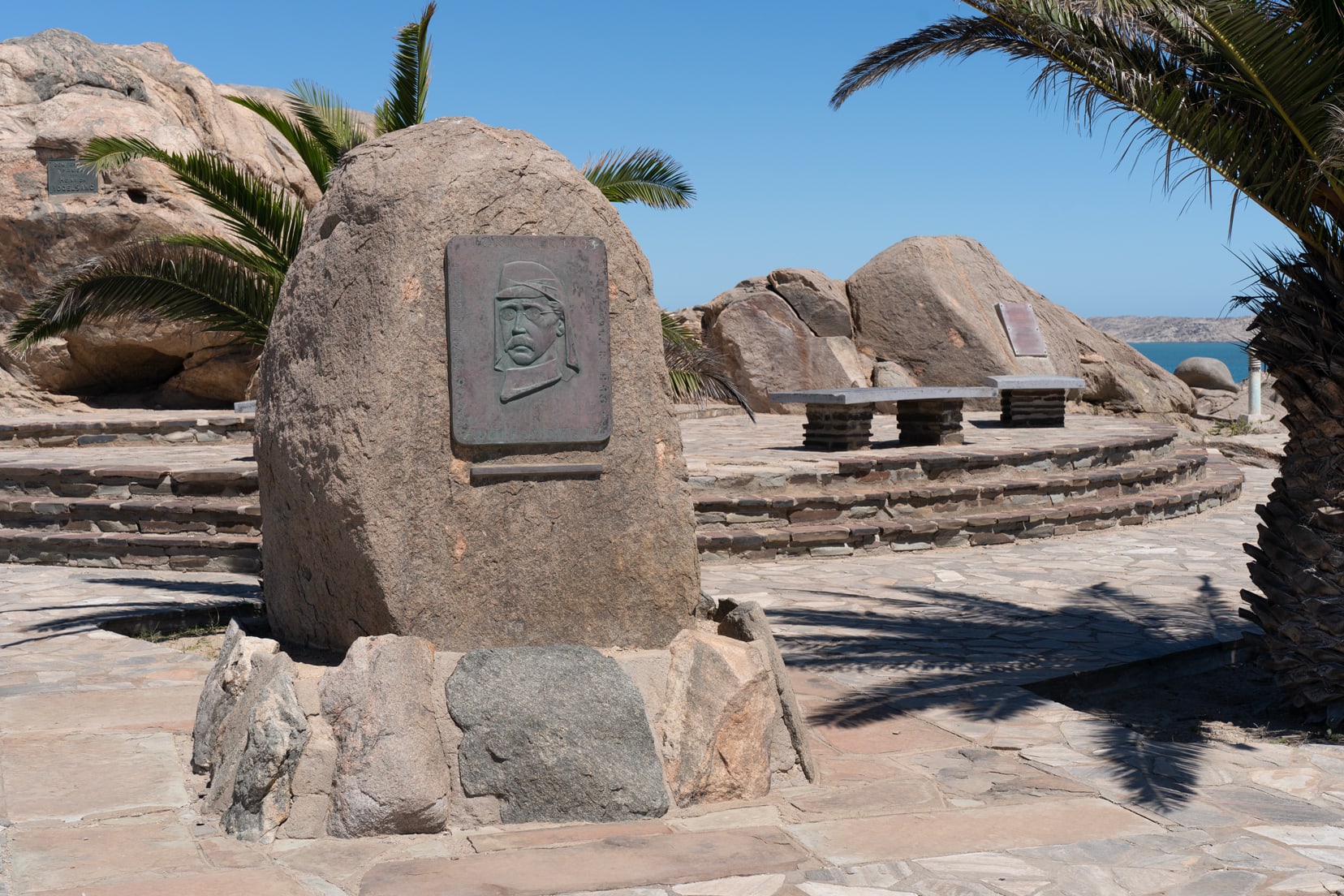
7. Stroll Along Agate Beach
On the way to the beach, just past the sewerage plant, we saw many gemsboks and a few springboks grazing on one of the few places where we encountered green vegetation.
It looked like there were allotments for growing vegetables near the sewerage plant – maybe benefiting from sewerage?
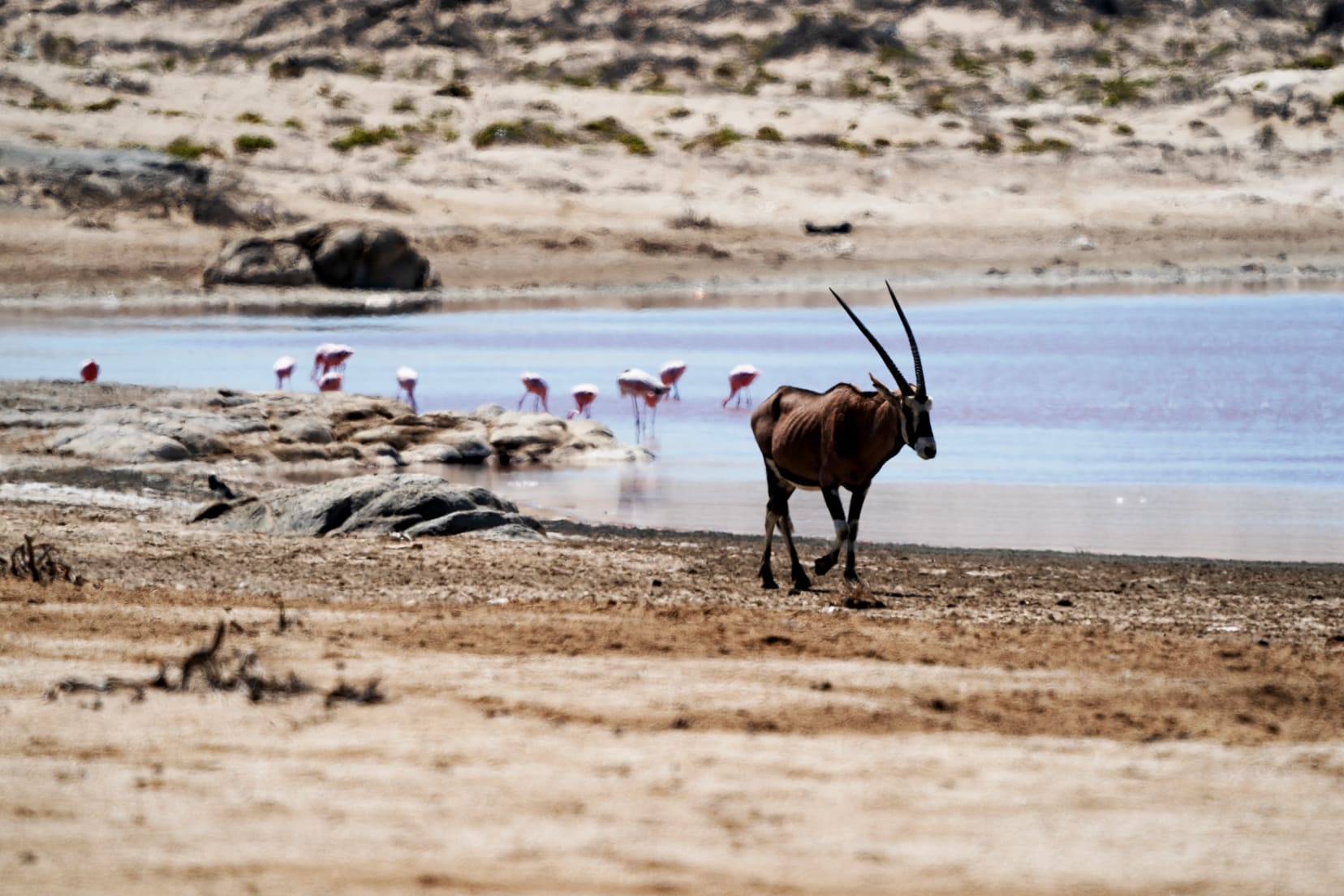
A bit further on, at the bottom of the hill from the sewerage plant, was a lake with a purple tinge. Maybe certain minerals in the water make it that colour or runoff from the plant?
Flamingos seemed happy to be feeding in there, so we’re assuming it’s not too bad.
Imagining the beach to be rocky, we were pleasantly surprised to find a sweeping stretch of sand. Braai (BBQ) stands and toilets were spaced out along the dunes.
You can find agate along the beach, but we didn’t spot any.
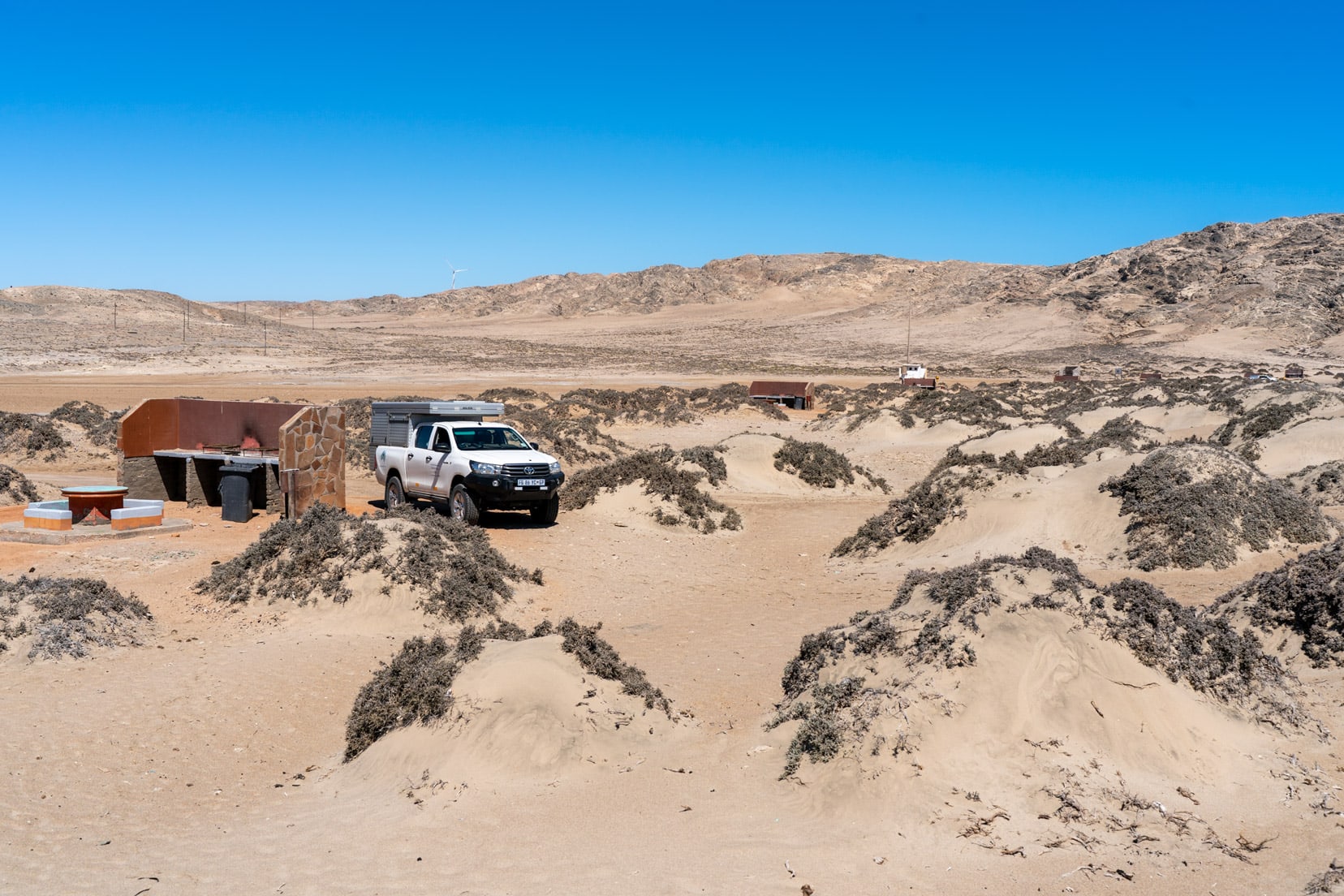
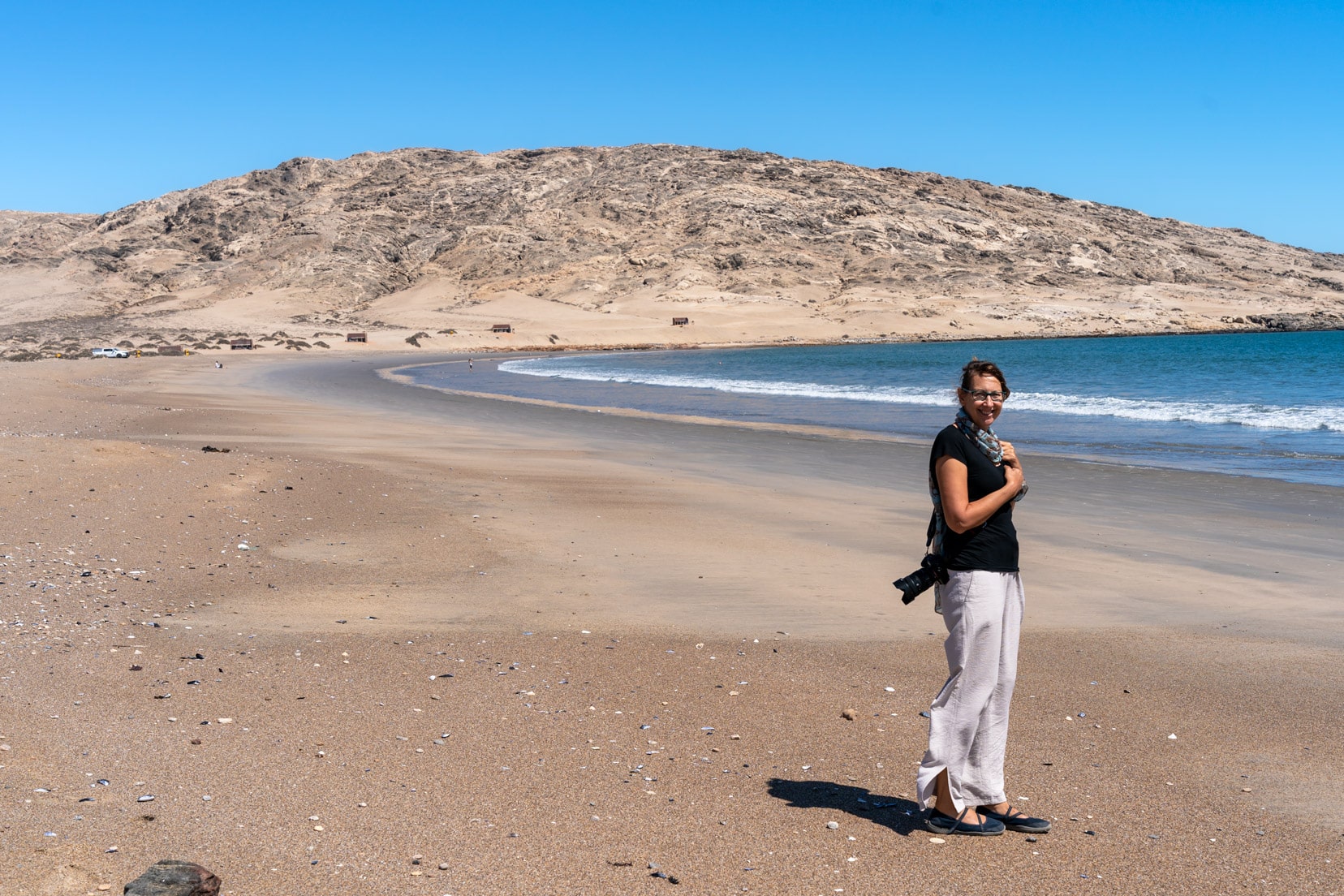
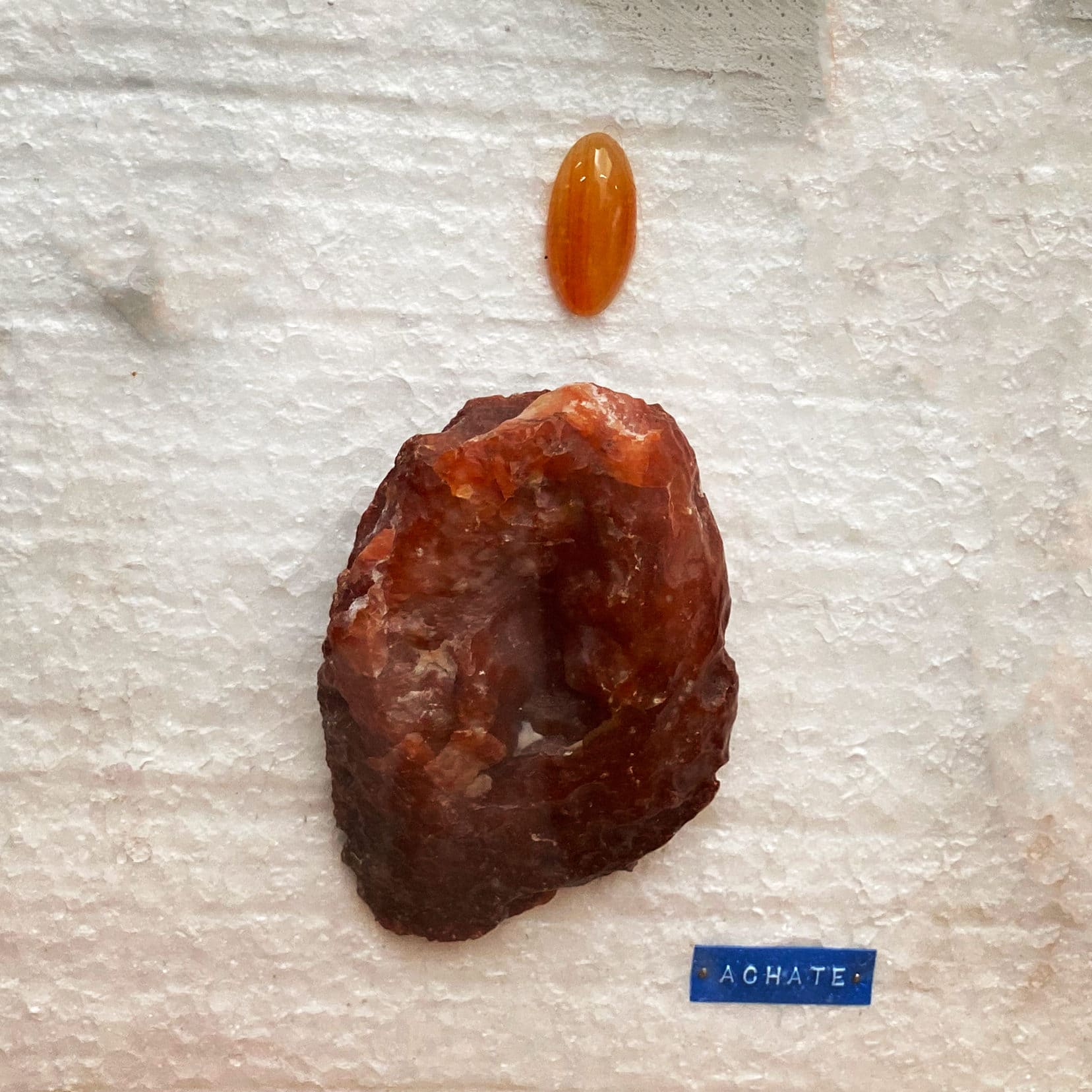
8. Visit Luderitz Museum
Luderitz Museum is on Diaz Street, just a short five-minute walk downhill from Felsenkirche, which can be seen from many places in the town as it is perched high on the granite outcrops.
The museum documents the town’s history and the diamond mining that was so monumental in the town’s growth. There are exhibits about Namibia’s indigenous people and their culture and information on local animal species.
Opening Times: Luderitz Museum is open from 3.30 pm to 5 pm, Monday to Friday, costing N$30.00 per person.

Luderitz History
Luderitz was originally called Angra Pequena (named by Dias) and, !Nami#Nûs by the local Nami People. In 1883, Adolf Luderitz, a German, bought Angra Pequena, which had become an important trading post, from the local Nami Chief.
Three years later, when he didn’t return from an expedition, the town was renamed in his honour to Luderitzbucht (Luderitz Bay).
In 1909, Luderitz flourished when diamonds were found and mined for a short period at the nearby town of Kolmanskop.

9. Eat seafood in Luderitz
“You must try the seafood at Luderitz,” implored the police officer who was dealing with our camper break-in while we were staying in Keetmanshoop.
(Side note: we had most of our clothes stolen but luckily, our cameras and laptops were with us – this is exactly why we have travel insurance!)
So, as you do when a police officer tells you to do something, we did indeed sample the seafood once we arrived in Luderitz.
If you are a regular reader, you’ll know that we are budget travellers who rarely eat out. Therefore, This was a treat, and we chose the Portuguese Fisherman as the local tourist information office recommended in the centre of town.
We love our fish and chips, so we had hake and chips with a side of calamari (however, the calamari didn’t come as a side, so it also came with chips). The waitress also convinced one of us to try the kingklip (a type of fish) as an alternative to the hake (which was, of course, more expensive … As it happened, we preferred the hake anyway, but when in Luderitz …
If you visit Luderitz in late April, you will want to time it around the Luderitz crayfish festival. It’s held annually. The crayfish festival Luderitz 2024 dates are still to be confirmed.

10 . Visit Felsenkirche
Felsenkirch, meaning rock church, was built in 1911 and has since become a national monument.
This relatively small church is at the top of the steep Diamond Hill. At the pinnacle, with its foundations built on rock, Felsenkirch overlooks the town and the ocean.
If you view the church from the ocean side, you’ll see it sits on the crest of the coastal rocks.
The inside of this Evangelical Lutheran church is modest, apart from the beautiful stained glass windows that dominate the walls. The stained-glass panel situated over the altar was donated by Kaiser Wilhelm II.
Opening Times: The church is open daily from 5-6 pm and is free of charge.

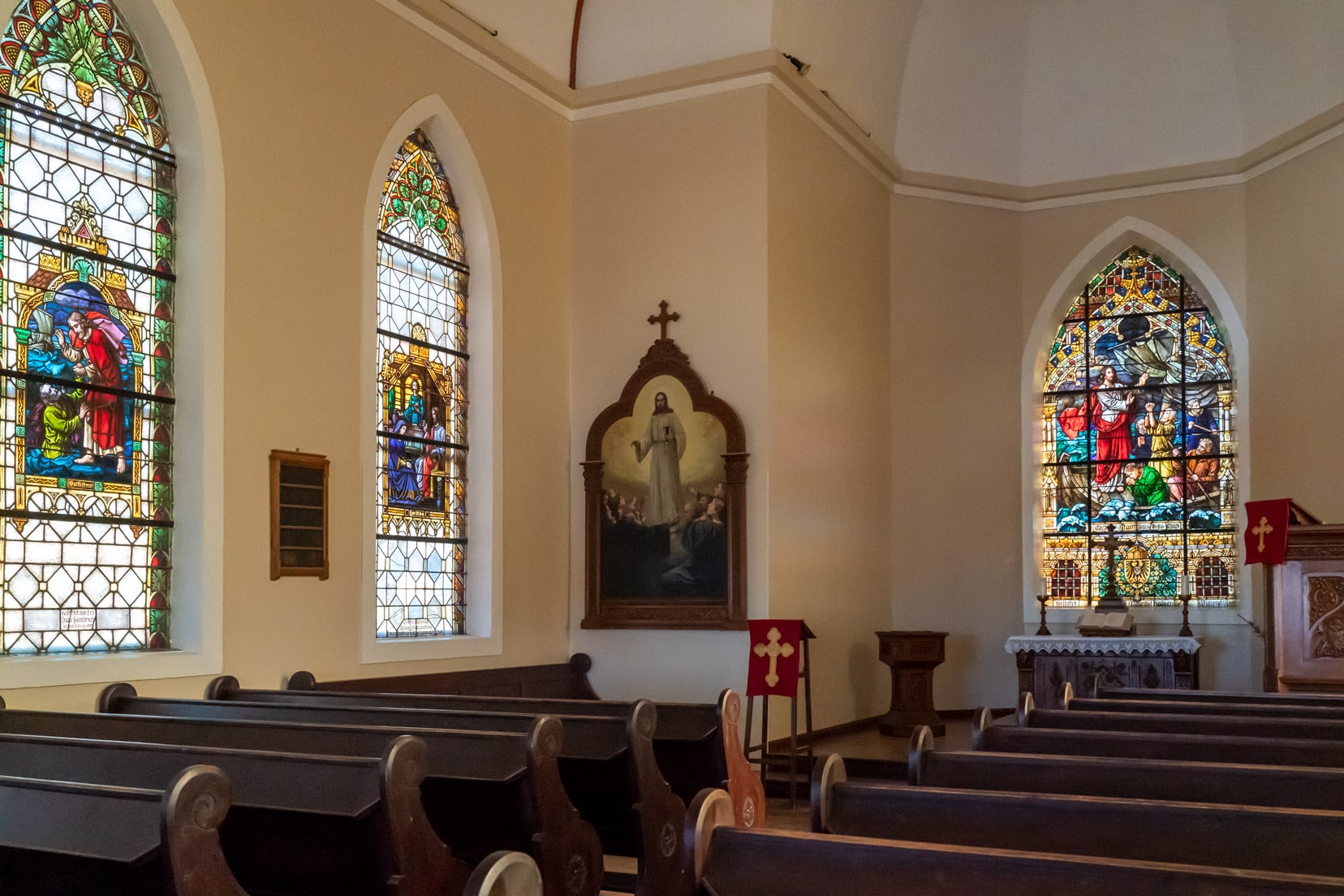
11. Windsurfing and Kite Surfing in Luderitz
With some of the strongest winds on record, it’s hardly surprising that Luderitz is home to the annual Lüderitz Speed Challenge. It’s normally held for about a month in November.
The Lüderitz Speed Challenge is an official Speed Record Chase for Windsurfers and Kitesurfer approved by the WSSRC (World Sailing Speed Record Council), which also partners with the Guinness World Records.
In 2021, legendary Dutch windsurfing legend Bjorn Dunkerbeck set a world speed record of 103.67 km/h at the Luderitz Speed Challenge.
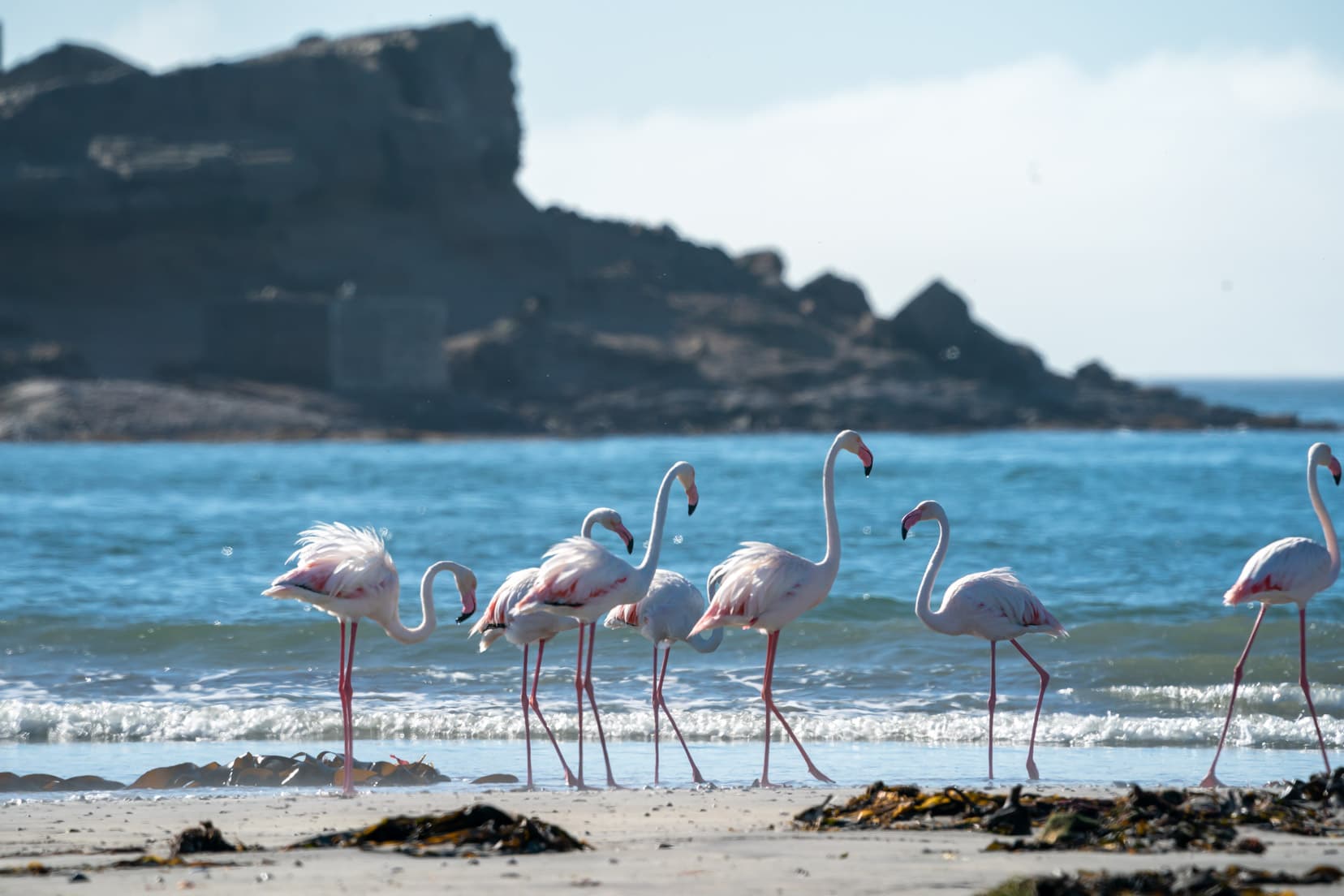
12. Catamaran to Halifax Island
Halifax Island, just off the west coast of Luderitz, is home to hundreds of African penguins.
You can grab a catamaran tour that leaves Luderitz Harbour daily at 8 am and returns at 10.15 am. The tour takes you around Dias Point, and you are likely to see the heavy-side dolphins and other marine life.
You need to book in advance, and the tour costs N$500.00 per person (Under 12s are free).
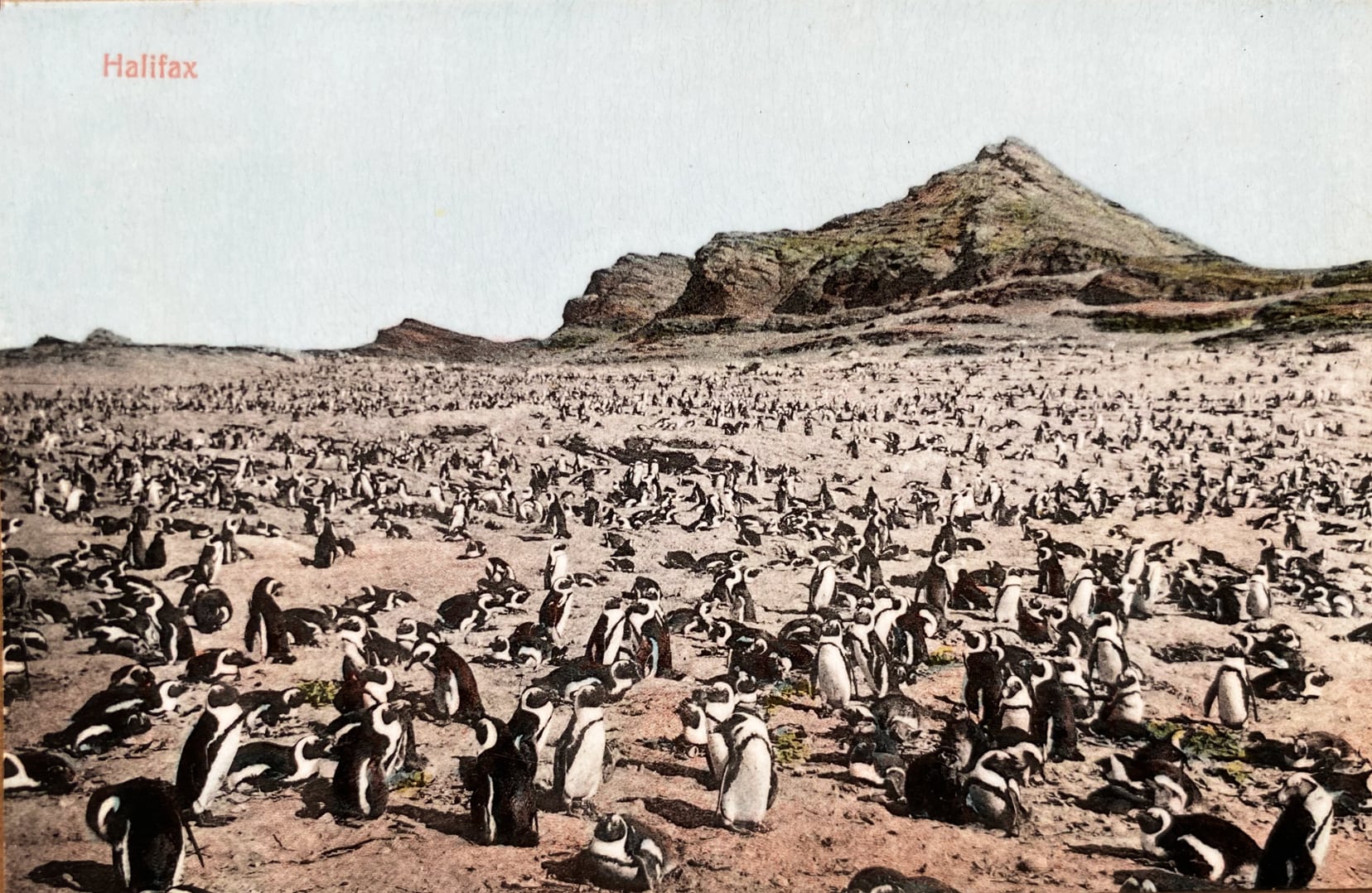
13. Visit the Sperrgebiet National Park
Sperrgebiet Park, now called Tsau//Khaeb National Park, is a diamond mining area and is also part of the Namib Desert. Sperrgebiet means the prohibited area in German, and even though many areas are not being actively mined, most of the park is still off-limits to the public.
The park is jointly owned by the Debeers Diamond Mining Company and the Namibian government — creating the Namdeb Diamond Corporation.
It isn’t possible to visit the park by yourself. Only those who hold a concession from the Ministry of Tourism and Environment can take you there.
Therefore, you need to arrange a tour. Some of these include visiting the Pomona Ghost Town and Boganfels Rock, a 55 m high lime rock arch formed like a bridge.
Enquire at the Tourist Information Centre in Bismarck Street for more information.
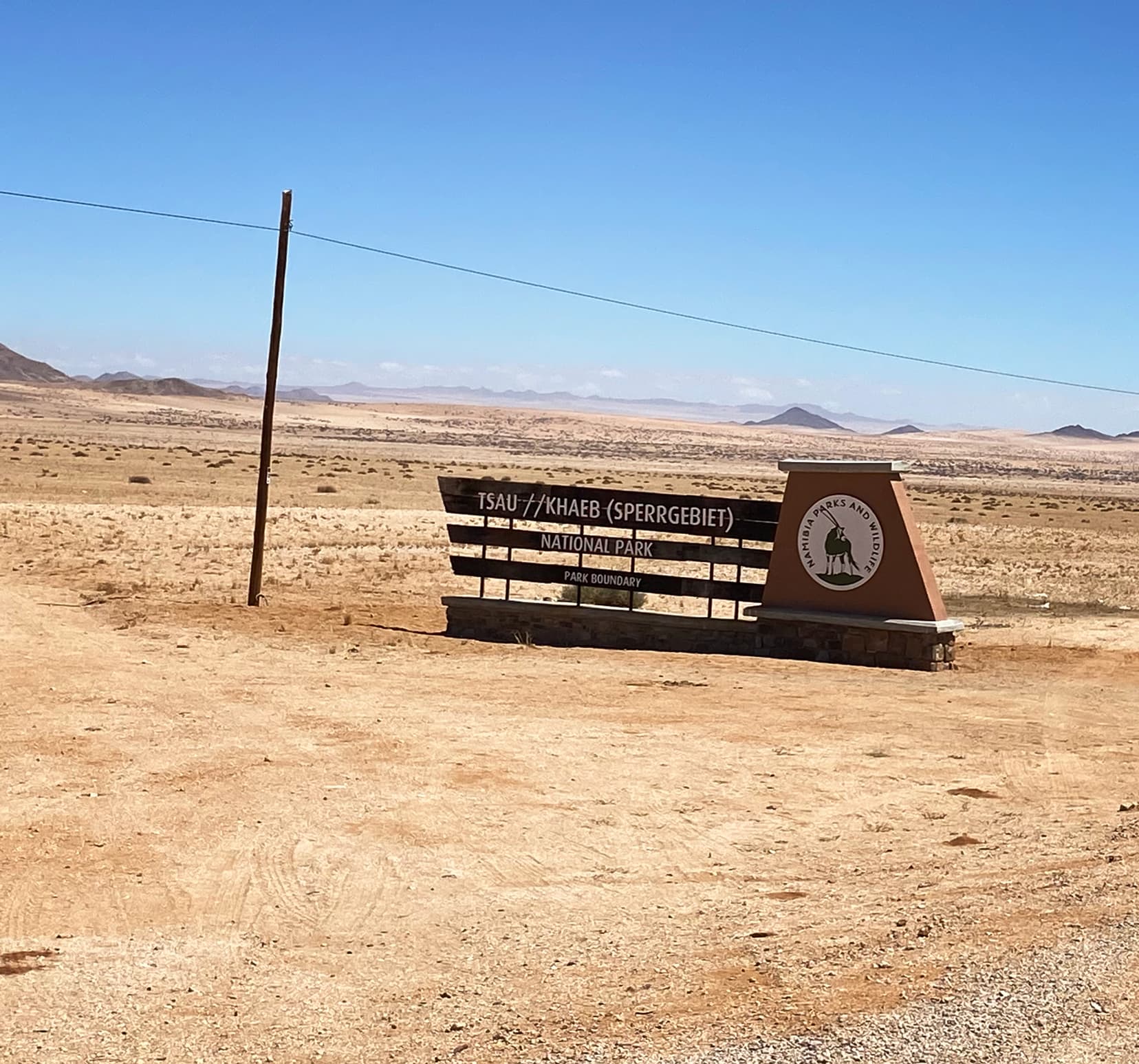
14. Stroll the town and admire its German Architecture
Luderitz was owned and colonised by the Germans from the early 20th century. Its buildings are, therefore, typically styled in the Art Nouveau style of that time.
One of the nicest streets, with bright and colourful houses, is the Berg, which also happens to be the street at the bottom of the hill from Felsenkirche.
The blue house on the corner is often photographed as a classic example of the interesting architecture in Luderitz.
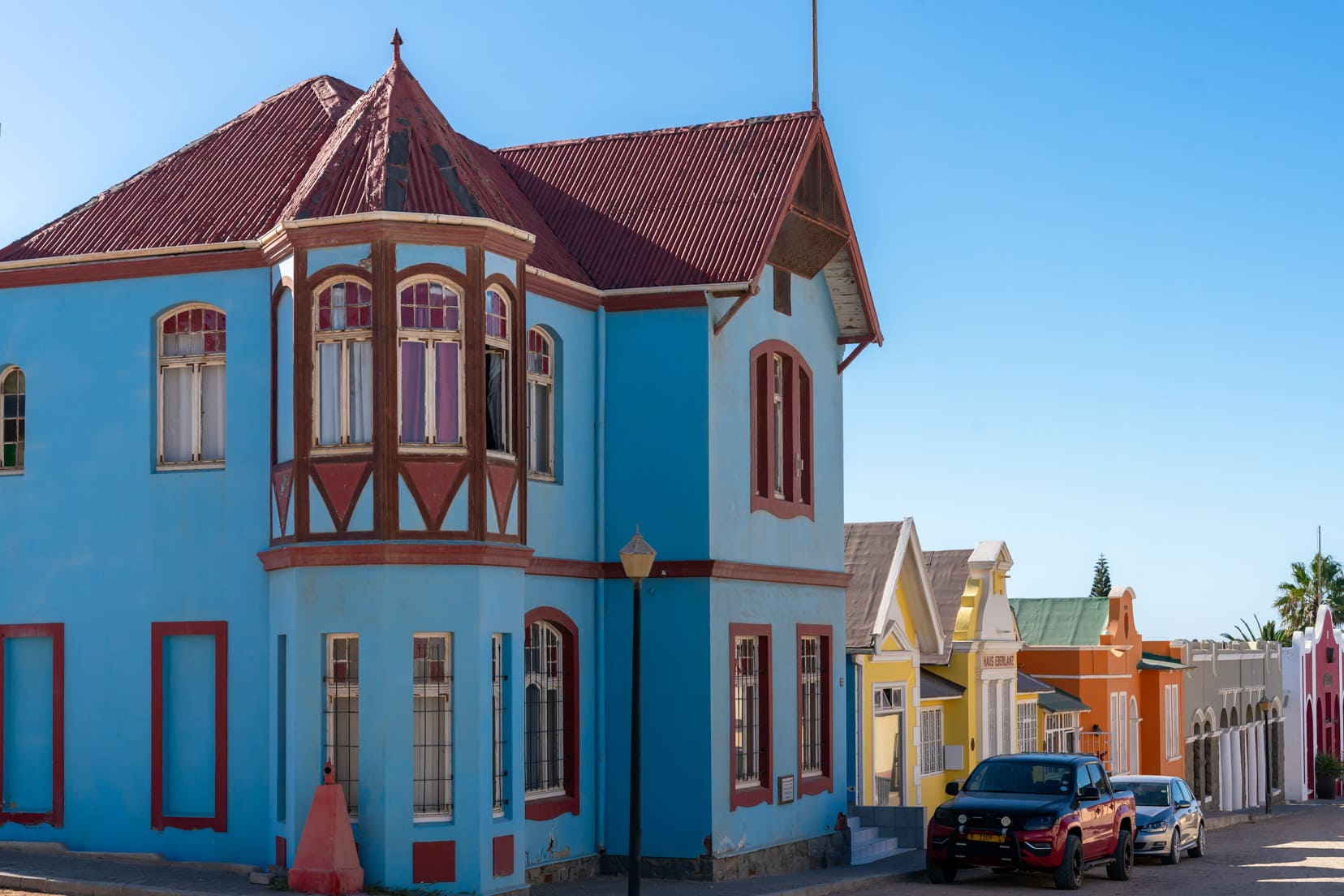
15. Visit Goerke Haus – Once one of the most Extravagant Houses of Luderitz
One of the houses in Luderitz, the Goerke Haus, is open as a museum and is listed as a National monument.
It was once one of the most extravagant houses in Luderitz. Lieutenant Hans Goerke owned Goerke Haus. It was designed by architect Otto Ertl and constructed in 1910, seemingly into the rocks around it.
Hans Goerke originally came to Namibia with the German colonial fighting force, but he later resigned and made his wealth in the diamond industry. He only lived in the house for two years, as he left Namibia, which at the time was known as South West Africa.
The house was later used as a magistrate’s house and a corporate guest house, and then it was renovated and opened as a museum.
Check the opening times at the Luderitz tourist information because the times seem to change regularly.
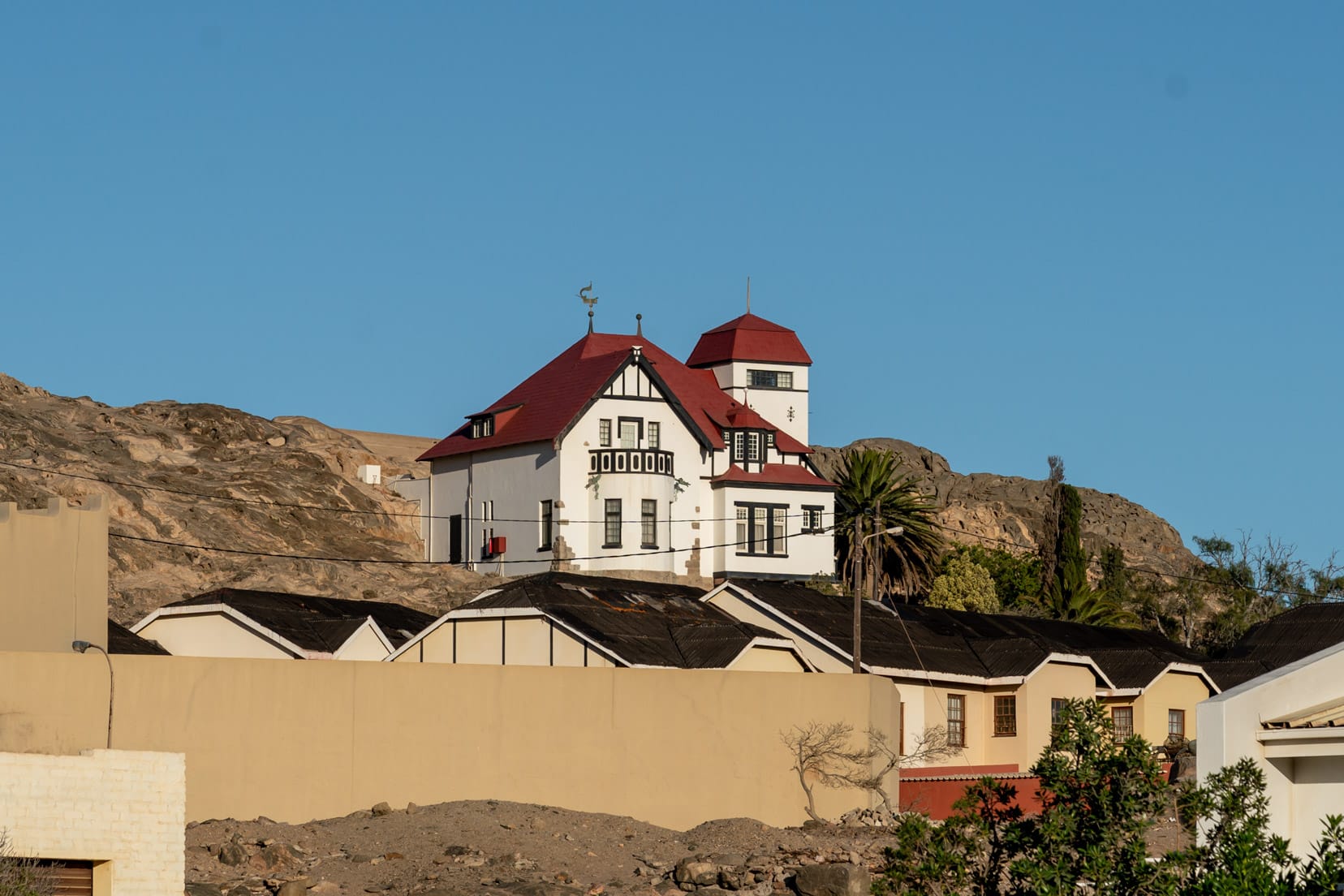
Where to Stay in Luderitz
We did look at camping, but when we realised how windy it can be in Luderitz, we opted to stay in an apartment instead.
We stayed in Ocean Life Apartments – which were one of the cheapest we could find. However, the TV wasn’t connected, and although advertised with free Wi-Fi, this was either not working or extremely slow.
The room was clean, though, and the shower was hot, so I guess it wasn’t too bad for the price. Unfortunately, we were blocked in the car park two mornings in a row, so that made the stay very frustrating.
🛏 We love using Booking. com because many options include free cancellation, saving you money if your plans change
How to Get to Luderitz
Luderitz is easily reached along the B4, which leads directly from Aus.
We’ve included various distances and times from other places in Namibia to help you plan your road trip.
- Distance from Keetmanshoop to Luderitz: 340km / 3.5 hours
- Distance from Swakopmund to Luderitz: 800 km / 9.5 hours
- Distance from Mariental to Luderitz: 484 km / 5.5 Hours
- Distance from Aus to Luderitz: 125 km / 1 hr 15 mins
Travelling to Luderitz offers a unique kind of isolation and beauty. For those on a long road trip, check out our Road Trip Tips for Couples to keep the journey fun and stress-free.
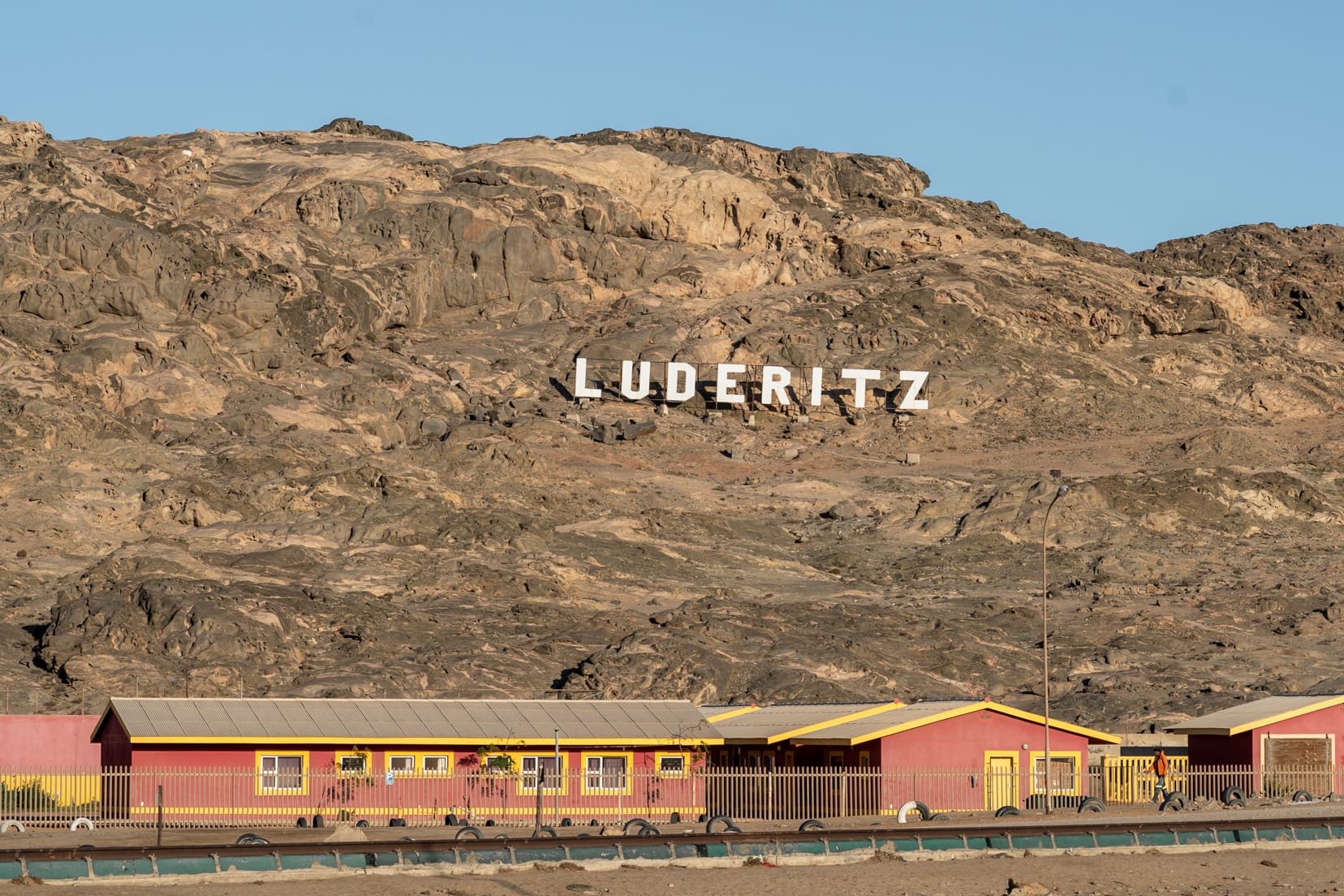
🚐 Thinking of Hiring a Camper in Namibia?
We recommend using Motorhome Republic to find you the best deal – they search all the local reputable African rental companies, including the most popular (we’ve seen them everywhere here), Avis and Britz
They do all the hard work for you and have a PRICE BEAT GUARANTEE
Planning your route to Luderitz? Our Printable Road Trip Planner can help you organize your adventure down to the last detail.
FAQS about LUDERITZ
1. Is Lüderitz worth a visit?
Luderitz is worth visiting, with its main attraction being the unique ghost town, Kolmanskop. What was once a bustling diamond mining town is now slowly being reclaimed by the desert — a fascinating sight.
But there are a host of other tourist attractions in Luderitz.
You can visit Garub Pan to spot Namib wild horses, find oryx and springbok wandering in the dunes by Luderitz’s Agate Beach, visit the local museum to find out about its diamond mining history, climb the hill to its church on the rocks, and taste the freshly caught seafood Luderitz is so famous for.
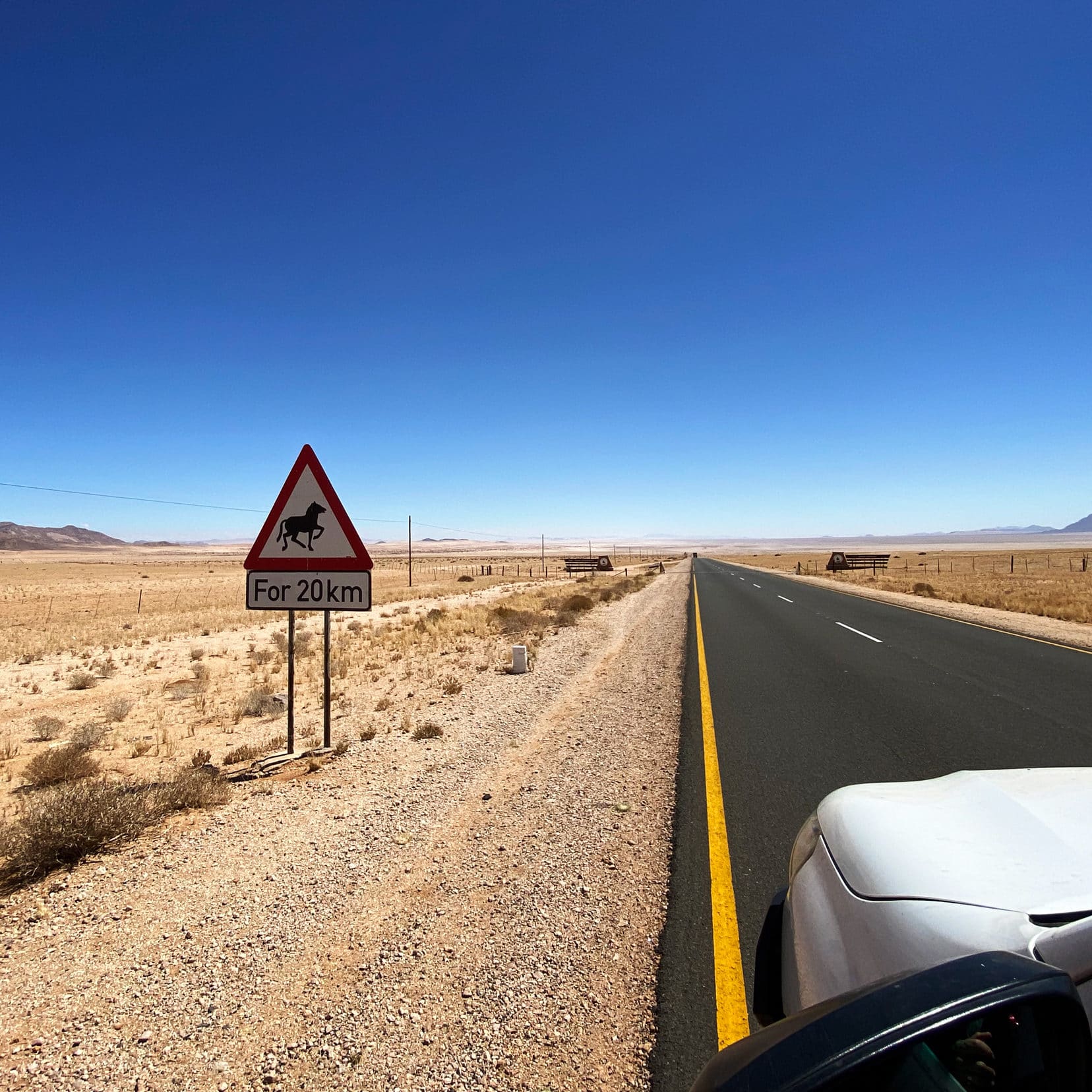
2. What is Lüderitz known for?
Luderitz is known for its diamond mining history, its marine wildlife such as heavy side dolphins, Cape fur seals and penguins, its seafood restaurants, its colonial German architecture, its incredible winds and for being the annual host of the Luderitz speed challenge.
3. Who discovered Lüderitz in Namibia?
Luderitz was first discovered by Portuguese explorer Bartolomeu Dias in 1488. He placed a cross in the Bay where he landed, naming the bay Angra Pequena, meaning Small Bay in Portuguese.
However, in 1883, Adolf Luderitz bought the rights of the land from the local Nama Chief.
Three years later, in 1886, Luderitz didn’t return from an expedition, and the town was renamed Luderitzbucht (Luderitz Bay) in his honour.
4. Is Kolmanskop worth it?
Kolmanskop is an incredible place that developed at the height of the diamond mining boom but was abandoned later when more lucrative mining sites were found further south.
To see how the desert is slowly reclaiming this town, with mounds of rippled sand encroaching into buildings, is a unique spectacle.
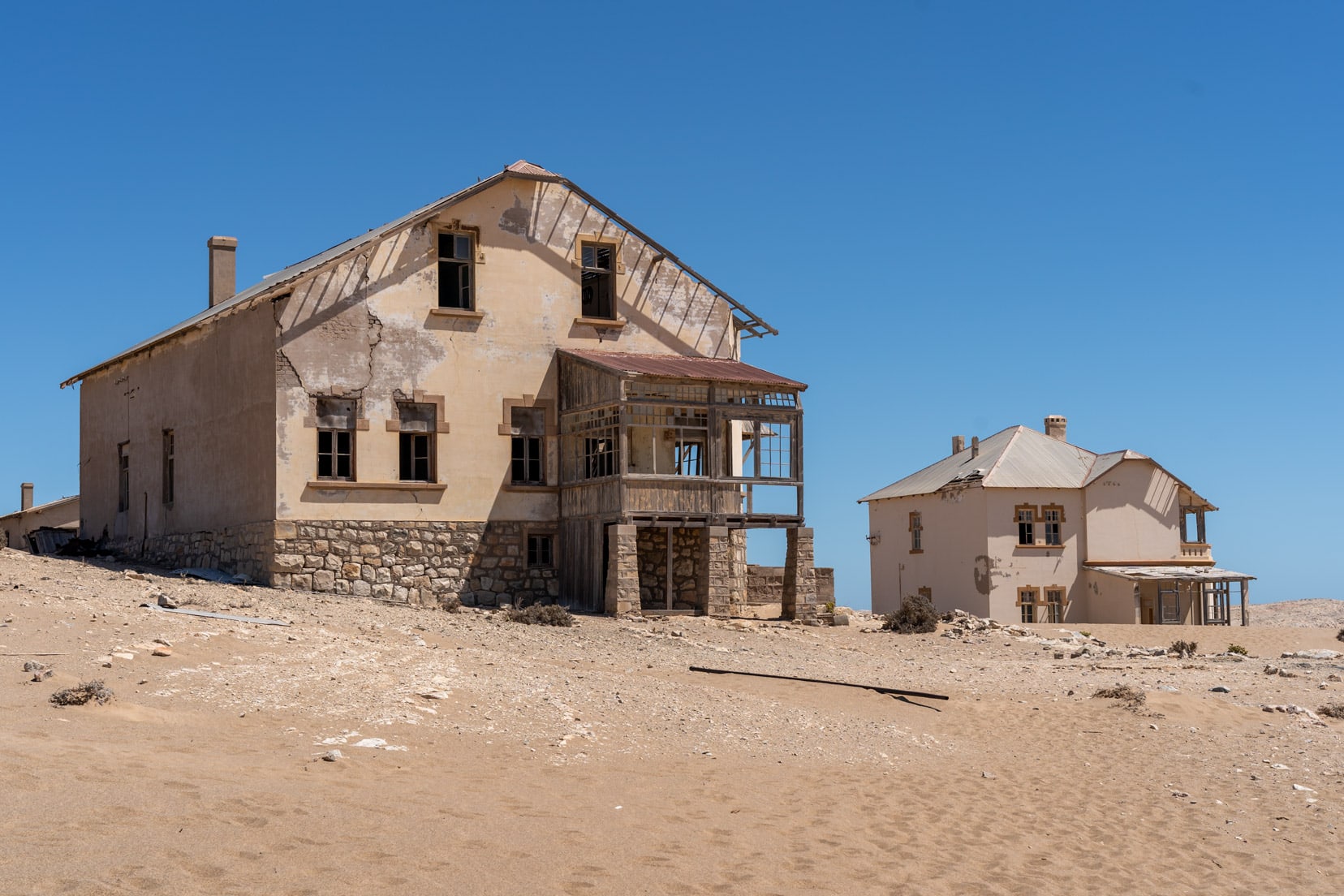
Things to do in Luderitz… That’s a Wrap
Luderitz isn’t one of the must-see places that pop up on a Namibian Road trip route, probably because it involves a detour inland from Aus.
But this part of Namibia’s southern coast is worth a stopover. Kolmanskop is magnetic enough, but Luderitz has a charm of its own, which is also worth stopping for.
From exploring the colonial architecture and museum exhibits to enjoying fresh seafood, bird watching, and beach combing, there are plenty of things to do in Luderitz for all types of travellers.
Read our story here, and we’d love for you to connect with us on Facebook or Instagram, where we share our photography and travels on this lifejourney4two.
Pin and Save for Later
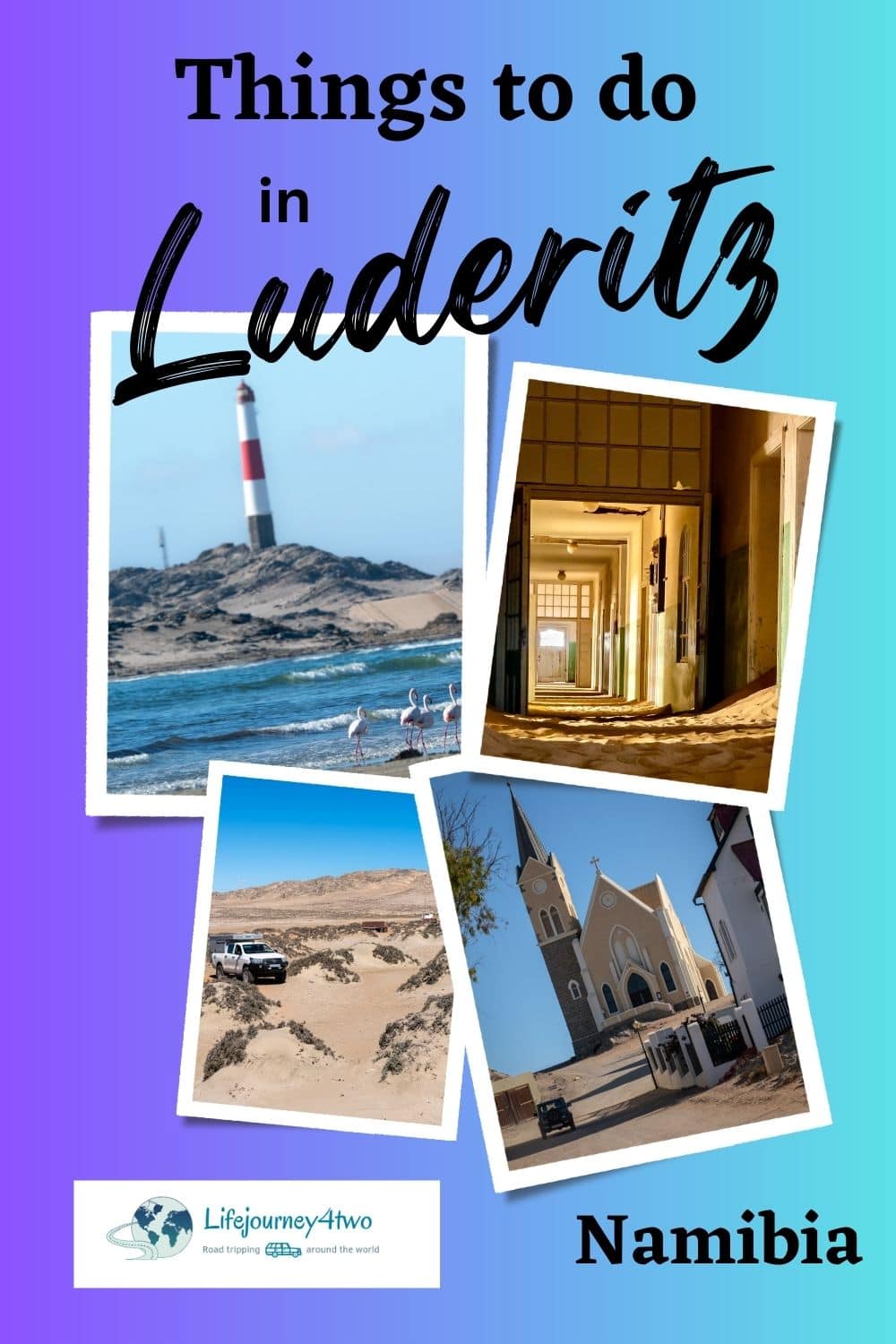
Related Posts
- Kanaan Desert Retreat: Magical Mountains and Meerkats, Namibia
- How to Visit Sossusvlei and Sesreim Canyon
- The Best Sandwich Harbour Tours from Walvis Bay, Namibia
- The Best Living Desert Tour in Swakopmund, Namibia
Planning Your Travels?
These are the travel resources we recommend and use when planning our trips.
- 🚘 Car Hire: We use DiscoverCars.com
- Motorhome/Campervan Rental: We highly recommend the Motorhome Republic
- 🪪 Order your International Driver’s Licence online here
- 🛏 Book Accommodation: We use Booking.com to find accommodation that suits our budget
- 🐶 Pet Sitting/Pet Sitters: Check Out TrustedHousesitters here (Use our Discount code: LIFEJOURNEY25 for 25% off. )
- Activities and Experiences: Get Your Guide and Viator
- Travel Insurance: Safetywing or World Nomads
- 🥾 Travel Gear and Accessories: Check out our top picks here — Lifejourney4two page on Amazon
For a more thorough list, visit our Travel Resources page here.


